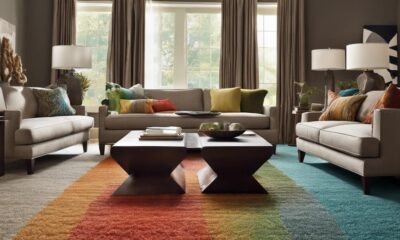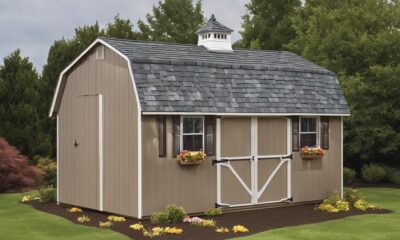Appliances
Why Do Ceiling Fans Have a Reverse Switch
2025
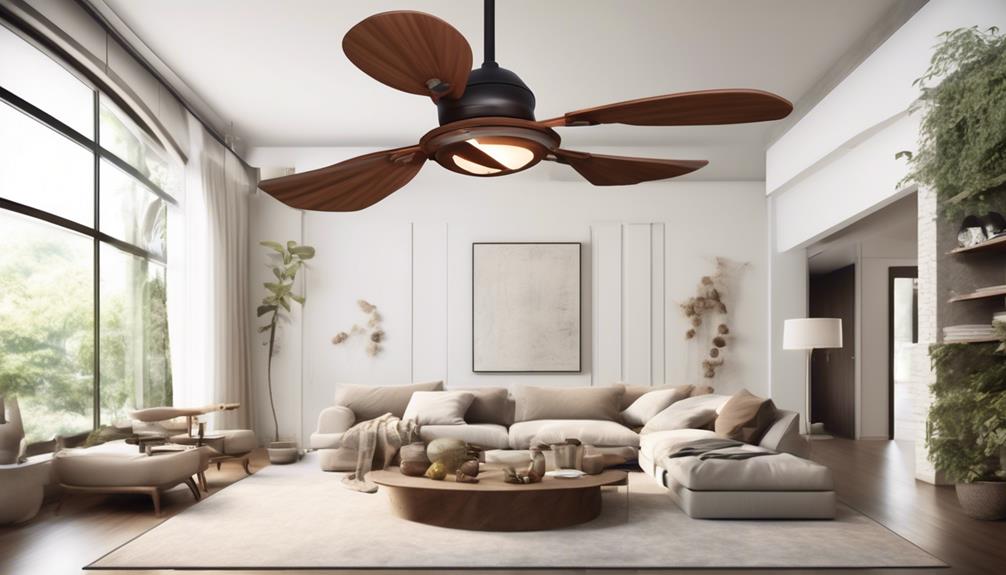
Ceiling fans are commonly found in numerous households, offering a dependable and affordable method of staying cool throughout the summer. However, you might be curious, why is there a reverse switch on ceiling fans?
It's a valid question, as the reverse switch may seem unnecessary or even confusing. However, this feature actually serves an important purpose. By reversing the direction of the fan blades, you can enhance air circulation and improve comfort in your home.
In this article, we will explore the reasons why ceiling fans have a reverse switch and how it can be utilized effectively throughout the year. So let's dive in and discover the benefits of this often overlooked feature.
Key Takeaways
- The reverse switch allows for efficient airflow management in any room, maximizing the benefits of a ceiling fan.
- The direction of the fan's rotation can be changed, with a counterclockwise direction creating a cooling effect in summer and a clockwise direction circulating warm air in winter.
- The reverse switch is crucial for effective temperature control during different seasons, optimizing energy consumption and enhancing the efficiency of heating and cooling systems.
- Optimizing the use of the reverse switch can maximize energy efficiency in winter, reduce heating costs, prevent air stagnation, and improve air quality.
Importance of the Reverse Switch
The reverse switch on a ceiling fan is a crucial component that allows for efficient airflow management and year-round comfort in any room. Its importance can't be overstated, as it plays a vital role in maximizing the benefits of a ceiling fan. Regular maintenance of this switch is essential to ensure its proper functioning and to prevent potential issues.
One of the primary reasons why the reverse switch is important is its ability to change the direction of the fan's rotation. During the summer months, setting the switch to the counterclockwise direction creates a cooling effect by pushing air downward. This creates a breeze that can make a room feel up to 8 degrees cooler without lowering the temperature. Conversely, during the winter months, setting the switch to the clockwise direction allows the fan to circulate warm air trapped near the ceiling. This helps to distribute the heat evenly throughout the room and can reduce heating costs.
Just like any other mechanical component, the reverse switch is subject to wear and tear over time. It's important to regularly inspect and clean the switch to prevent dust and debris from interfering with its operation. If the reverse switch becomes faulty, troubleshooting common issues such as loose connections or worn-out components can often resolve the problem. However, if the switch is beyond repair, it may need to be replaced to maintain the desired airflow control.
Understanding Airflow Direction

Understanding the airflow direction of a ceiling fan is crucial for maximizing its effectiveness.
By knowing how the air circulates, we can harness the benefits of improved air circulation in our living spaces.
Additionally, understanding how to control the airflow direction allows us to use ceiling fans as an effective tool for seasonal temperature control, helping to keep us comfortable all year round.
Air Circulation Benefits
To maximize the benefits of air circulation, it's important to understand the direction of airflow in ceiling fans. By controlling the airflow, ceiling fans can help regulate temperature in a room and provide comfort. Here are some key benefits of air circulation:
- Improved cooling: Ceiling fans create a wind chill effect by moving air across the skin, making you feel cooler even in warm temperatures.
- Energy efficiency: By using ceiling fans in conjunction with air conditioning, you can set the thermostat higher and still feel comfortable, reducing energy consumption and lowering utility bills.
- Enhanced ventilation: Ceiling fans can help circulate fresh air throughout a room, removing stagnant air and odors.
- Winter warmth: Reversing the direction of the fan blades pushes warm air downwards, helping to distribute heat evenly and reducing reliance on heating systems.
Understanding airflow direction and utilizing it effectively can significantly improve the comfort and energy efficiency of any space.
Seasonal Temperature Control
During different seasons, understanding the direction of airflow in ceiling fans is crucial for effective temperature control. Airflow management plays a significant role in maintaining a comfortable indoor environment while optimizing energy consumption. By adjusting the direction of the ceiling fan blades, you can enhance the efficiency of heating and cooling systems, reducing the need for excessive energy usage.
To illustrate the importance of airflow direction in seasonal temperature control, consider the following table:
| Season | Airflow Direction | Benefits |
|---|---|---|
| Summer | Counter-clockwise | Creates a cooling breeze, making you feel up to 8 degrees cooler. Reduces the strain on air conditioning system, leading to energy savings. |
| Winter | Clockwise | Pushes the warm air near the ceiling down into the living space, improving heat distribution. Allows for lower thermostat settings and reduces heating costs. |
Cooling Effect in Summer
In the summer months, ceiling fans are a highly effective tool for creating a cooling breeze in any room. They can help to lower the temperature and make the space more comfortable.
Here are a few reasons why ceiling fans are so effective in providing a cooling effect:
- Circulation: Ceiling fans work by circulating the air in a room, creating a gentle breeze that helps to evaporate moisture from our skin, making us feel cooler.
- Evaporative Cooling: By creating air movement, ceiling fans enhance the process of evaporative cooling. As the breeze from the fan passes over our skin, it accelerates the evaporation of moisture, which cools us down.
- Energy Efficiency: Ceiling fans are an energy-efficient way to cool a room. They use much less electricity than air conditioners, helping to minimize the impact on electricity consumption and maximize energy efficiency.
- Zoning: Ceiling fans allow for targeted cooling, as they can be installed in specific areas where cooling is needed the most. This helps to avoid wasting energy on cooling the entire space when it's not necessary.
Enhanced Air Circulation
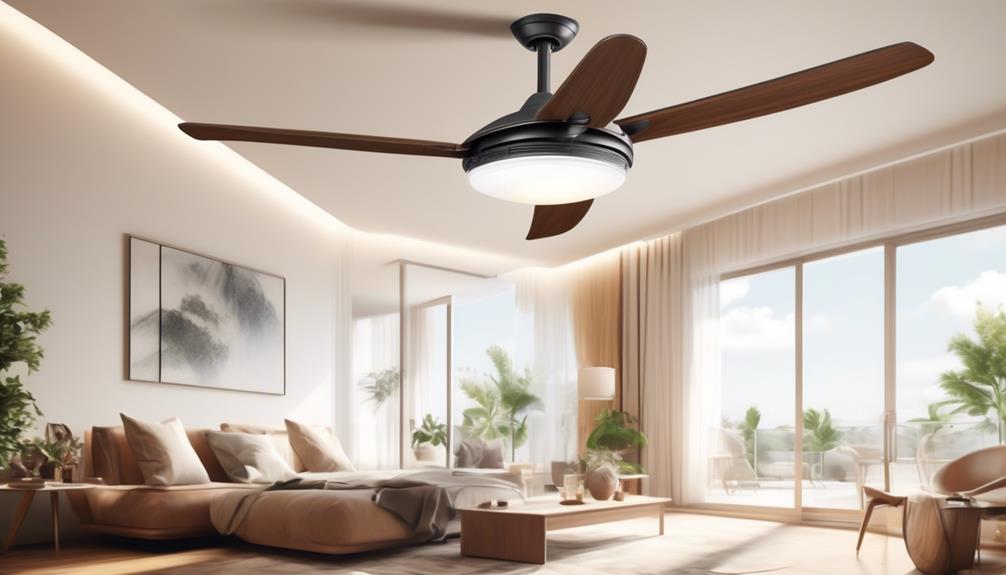
Ceiling fans excel at enhancing air circulation within a room, promoting a more comfortable and refreshing environment. With their ability to move large volumes of air, ceiling fans contribute to improved ventilation and air movement control. By strategically placing ceiling fans in different areas of a room, you can optimize the airflow and create a more balanced distribution of cool or warm air.
To better understand the impact of ceiling fans on air circulation, let's take a look at the following table:
| Position | Direction | Effect |
|---|---|---|
| Forward | Clockwise | Creates a cooling breeze by pushing air downwards. Ideal for hot summer days. |
| Reverse | Counterclockwise | Recirculates warm air trapped near the ceiling, improving heating efficiency during colder months. |
| Oscillating | Alternating | Provides a wider coverage of air movement, reaching different parts of the room. |
In the forward position, the ceiling fan's blades rotate in a clockwise direction, which creates a cooling breeze as air is pushed downwards. This effect is ideal for hot summer days when you want to feel a refreshing breeze.
In the reverse position, the fan blades rotate in a counterclockwise direction. This recirculates warm air that tends to accumulate near the ceiling, improving heating efficiency during colder months. By running the fan in reverse, you can evenly distribute warm air throughout the room, creating a more comfortable and cozy environment.
Some ceiling fans also offer an oscillating feature, where the fan rotates back and forth, providing a wider coverage of air movement. This helps to reach different parts of the room and ensures a more uniform airflow.
Energy Efficiency in Winter
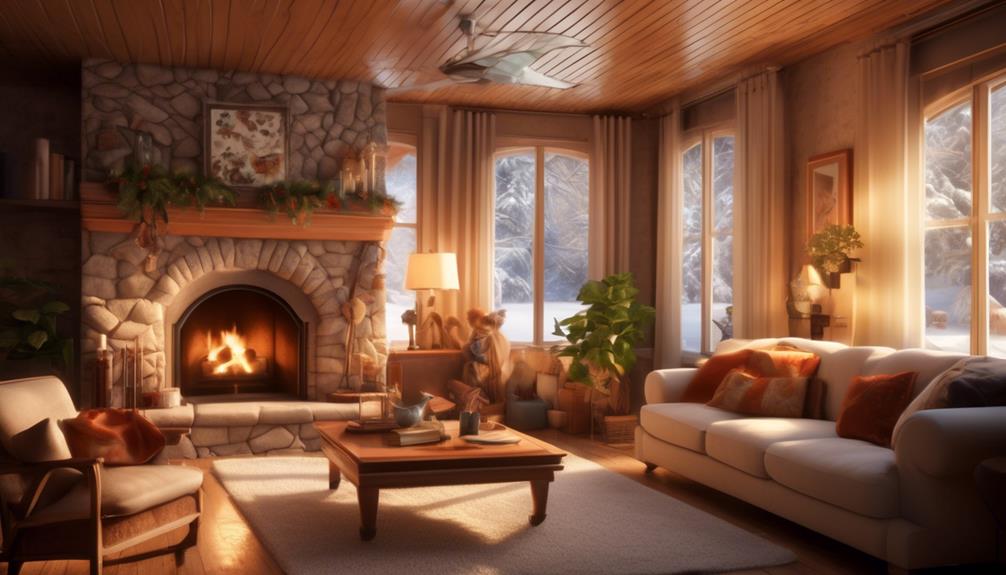
To maximize energy efficiency in winter, it's important to optimize the use of your ceiling fan's reverse switch. This switch allows the blades to rotate clockwise, creating an updraft that helps circulate warm air trapped near the ceiling downwards into the living space. By using the reverse switch correctly, you can effectively distribute heat throughout the room and reduce your reliance on heating systems.
Here are some key benefits of utilizing your ceiling fan's reverse switch for energy efficiency in winter:
- Enhanced temperature control: The reverse switch helps to maintain a consistent temperature by preventing warm air from rising and accumulating near the ceiling. This ensures that the entire room is heated evenly, eliminating cold spots and drafts.
- Reduced energy consumption: By using your ceiling fan in conjunction with your heating system, you can lower the thermostat setting without sacrificing comfort. This can lead to significant energy savings and reduce your utility bills.
- Improved air quality: As warm air is circulated downwards, it helps to eliminate stagnant air and prevent the buildup of dust and allergens. This promotes better indoor air quality, which is particularly important during the winter months when homes are often sealed tightly.
- Extended heating system lifespan: By reducing the workload on your heating system, the reverse switch can help prolong its lifespan. This can save you money on repairs and replacements in the long run.
Reducing Heating Costs
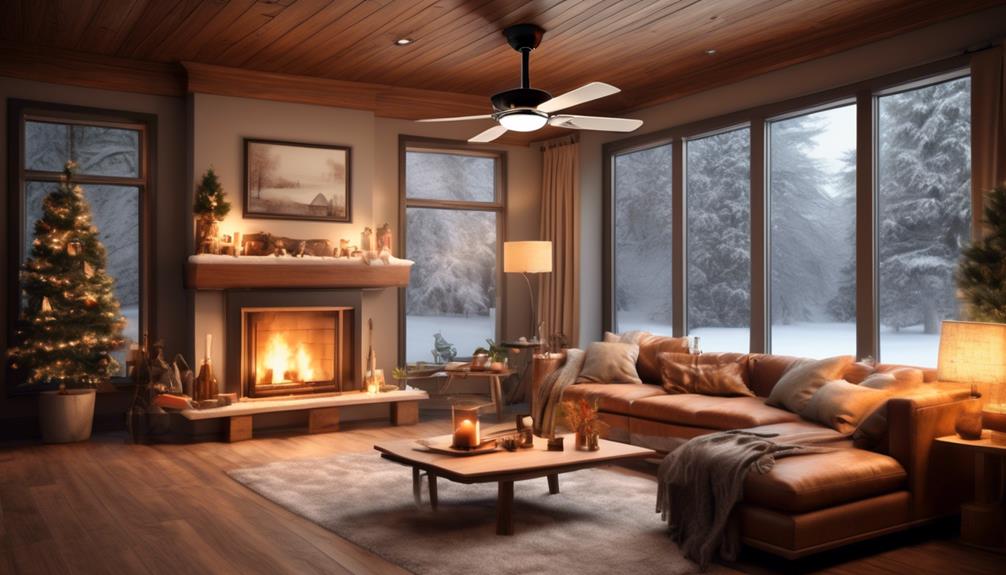
When optimizing energy efficiency in winter, one important aspect to focus on is reducing heating costs. By utilizing ceiling fans in conjunction with your heating system, you can effectively lower your energy consumption and save on heating expenses.
Ceiling fans have a reverse switch that allows you to change the direction of the airflow. In the winter, it's crucial to optimize the airflow direction to enhance the efficiency of your heating system. By setting your ceiling fan to rotate in reverse, the fan blades will push the warm air trapped near the ceiling down towards the floor, creating a more balanced and comfortable environment. This helps to distribute the heat evenly throughout the room, reducing the workload on your heating system and ultimately lowering your energy consumption.
To effectively reduce heating costs, it's essential to understand the proper use of your ceiling fan's reverse switch. Set the fan to operate at a low speed in reverse mode to avoid creating a cooling effect. This allows the fan to gently circulate the warm air without creating a draft. Remember to adjust the thermostat accordingly, as the warm air circulated by the fan will make the room feel warmer.
Preventing Air Stagnation

When it comes to preventing air stagnation, ceiling fans play a crucial role in promoting air circulation.
By circulating the air, ceiling fans help to prevent pockets of stagnant air from forming, which can lead to a stuffy and uncomfortable environment. This not only improves the overall comfort levels in a room but also helps to maintain a healthier indoor environment.
Additionally, the improved air circulation provided by ceiling fans can help to reduce heating costs during the winter months by distributing warm air more effectively throughout the space.
Air Circulation Benefits
In order to prevent air stagnation, ceiling fans play a crucial role in maintaining proper air circulation within a room. By promoting airflow control, ceiling fans help to distribute air evenly throughout the space, preventing pockets of stagnant air from forming. This not only improves comfort levels but also reduces the likelihood of musty odors and the growth of mold and mildew.
Additionally, ceiling fans contribute to energy savings by allowing for better temperature regulation. In the summer, the gentle breeze created by the fan can make a room feel cooler, allowing for higher thermostat settings and reduced reliance on air conditioning.
In the winter, by reversing the direction of the fan, warm air that rises to the ceiling is pushed back down, helping to maintain a consistent temperature and reducing the need for excessive heating.
Winter Heating Savings
By continuing our exploration of the benefits of ceiling fans, we now turn our attention to their role in winter heating savings, specifically in preventing air stagnation.
During the colder months, when we rely heavily on heating systems to keep our homes warm, ceiling fans can play a crucial role in maximizing warmth and reducing energy consumption.
The reverse switch on ceiling fans allows them to operate in a clockwise direction, which gently pushes warm air that naturally rises towards the ceiling back down into the room.
This simple yet effective technique helps to distribute the warm air evenly throughout the space, preventing it from stagnating near the ceiling.
As a result, the entire room benefits from the increased warmth, reducing the need to use heating systems at higher temperatures and increasing winter energy savings.
Improved Comfort Levels
To ensure improved comfort levels and prevent air stagnation, the reverse switch on ceiling fans can be activated to gently circulate warm air that naturally rises towards the ceiling back down into the room. This feature plays a crucial role in improving airflow and temperature regulation, providing a more comfortable environment for the occupants.
Here are four reasons why activating the reverse switch can enhance your comfort levels:
- Preventing air stagnation: By continuously circulating the air, the reverse switch prevents the buildup of stale air and keeps the room feeling fresh and invigorating.
- Balancing temperature distribution: The upward flow of warm air is redirected downwards, ensuring that every corner of the room receives a consistent temperature, eliminating cold spots.
- Enhancing air quality: The continuous movement of air helps to reduce the concentration of allergens, dust, and other particles, resulting in better indoor air quality.
- Reducing humidity: The circulation of air helps to reduce humidity levels, creating a more pleasant and comfortable atmosphere.
Balancing Room Temperature

To achieve a well-balanced room temperature, it's important to utilize the reverse switch on your ceiling fan. The reverse switch is a useful feature that allows the fan blades to rotate in the opposite direction, creating an updraft. This updraft helps to circulate air in the room, improving room ventilation and aiding in temperature regulation.
When the reverse switch is activated, the fan blades push the air upwards towards the ceiling. This creates a gentle updraft that helps to distribute warm air that naturally rises to the ceiling, back down to the living space. By doing so, it helps to create a more even distribution of warm air throughout the room, preventing hot spots and cold drafts.
Furthermore, the reverse switch can also be used during the summer months to create a cooling effect. By directing the air downward, the fan creates a breeze that helps to evaporate perspiration from our skin, making us feel cooler. This can help reduce the reliance on air conditioning, leading to energy savings.
Changing the Direction of the Fan
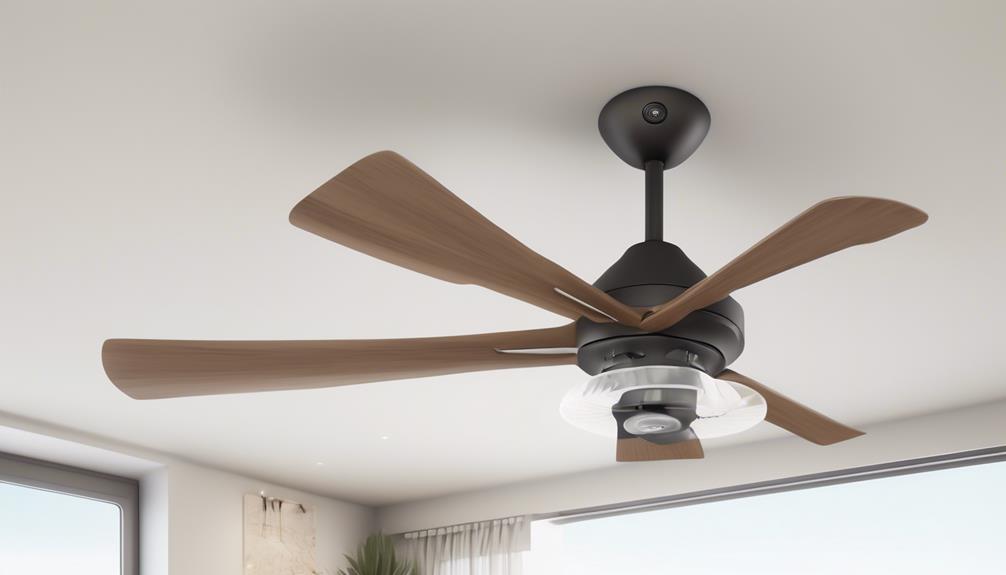
When it comes to changing the direction of the fan, there are several important points to consider.
First, reversing the fan's direction can provide a range of benefits, such as improved air circulation and increased comfort.
Second, it's important to note that changing the direction of the fan can also have an impact on energy efficiency, as it can help distribute warm air in the winter and cool air in the summer.
Lastly, understanding the seasonal cooling options that reversing the fan provides can help optimize its performance and maximize its effectiveness in maintaining a comfortable indoor environment.
Benefits of Reversing
Reversing the direction of the ceiling fan can provide a multitude of benefits, enhancing the comfort and energy efficiency of the space. When the fan is set to reverse, it creates a gentle updraft that has several positive effects.
- Reducing Allergies: By circulating the air upwards, the fan helps to prevent dust, pollen, and other allergens from settling on surfaces. This can significantly reduce allergic reactions and improve indoor air quality.
- Promoting Sleep Quality: The updraft created by the reverse fan helps to distribute cool air evenly throughout the room. This can create a soothing breeze that promotes better sleep quality by keeping the room at a comfortable temperature.
- Energy Efficiency: Reversing the fan also allows you to make better use of your heating and cooling systems. By distributing conditioned air more effectively, you can reduce the load on your HVAC system and potentially lower energy consumption.
- Enhanced Comfort: Reversing the ceiling fan can create a pleasant and refreshing breeze in the room, even during the colder months. This can help to maintain a comfortable environment without relying solely on heating or air conditioning.
Energy Efficiency Impact
Changing the direction of the ceiling fan can have a significant impact on the energy efficiency of the space. When the fan is set to rotate counterclockwise, it creates a cooling effect on the occupants of the room. This allows for a higher thermostat setting, which in turn leads to energy savings.
By circulating the air in a downward direction, the fan creates a wind-chill effect, making the room feel cooler without actually lowering the temperature. This can result in energy savings of up to 30% during the summer months.
On the other hand, when the fan is set to rotate clockwise, it helps to distribute warm air that rises to the ceiling. This allows for better temperature control and can reduce the need for heating.
Seasonal Cooling Options
To optimize the cooling capabilities of a ceiling fan, it's essential to understand the benefits of adjusting its direction during different seasons. By changing the direction of the fan, you can maximize its efficiency and comfort level in your space.
Here are some seasonal cooling alternatives that highlight the benefits of ceiling fans:
- In the summer, set the fan to rotate counterclockwise. This creates a cool breeze that helps evaporate moisture from your skin, making you feel cooler.
- In the winter, set the fan to rotate clockwise. This pushes warm air trapped near the ceiling downward, distributing it evenly throughout the room and reducing heating costs.
Ceiling fans can provide energy savings year-round by allowing you to raise your thermostat temperature without sacrificing comfort.
By using ceiling fans in conjunction with your air conditioning or heating systems, you can achieve a more balanced and efficient cooling and heating effect.
Mastering the art of adjusting your ceiling fan's direction based on the season will ensure optimal comfort and energy savings in your home.
Benefits for Vaulted Ceilings

What advantages do vaulted ceilings offer when it comes to installing and utilizing ceiling fans?
Vaulted ceiling design presents a unique opportunity for homeowners to optimize the installation and usage of ceiling fans. The distinctive architectural feature of a vaulted ceiling, with its sloping sides and elevated height, allows for better air circulation and distribution throughout the room. This is particularly beneficial in spaces with a larger volume of air, as the ceiling fan can effectively move air to all corners of the room, creating a more comfortable environment.
When installing ceiling fans in vaulted ceilings, there are several important considerations to keep in mind. The first is the height at which the fan should be mounted. Since vaulted ceilings are higher than standard ceilings, it's crucial to choose a fan with an extended downrod to ensure proper clearance and airflow. Additionally, selecting a fan with a reversible motor is highly recommended. This feature allows the fan to operate in both the forward and reverse directions, enabling it to effectively cool or heat the room, depending on the season.
Improved Comfort and Air Quality

Improved comfort and air quality can be achieved with the installation and proper use of ceiling fans in vaulted ceilings. Ceiling fans aren't only functional but also provide a range of benefits that contribute to a more comfortable living environment. Here are some ways in which ceiling fans improve ventilation and temperature regulation:
- Enhanced air circulation: Ceiling fans help to circulate the air in a room, preventing stagnant air and promoting a fresh and comfortable atmosphere.
- Improved airflow: By creating a gentle breeze, ceiling fans facilitate the movement of air, which can help to alleviate stuffiness and maintain a consistent temperature.
- Better temperature control: Ceiling fans can be used in conjunction with air conditioning or heating systems to distribute conditioned air more effectively, reducing the reliance on these systems and potentially saving energy.
- Reduced humidity: Ceiling fans can help to reduce excessive humidity in a room by promoting air movement. This can be particularly beneficial in areas prone to high humidity, as it helps to prevent the growth of mold and mildew.
Using the Reverse Switch for Different Seasons
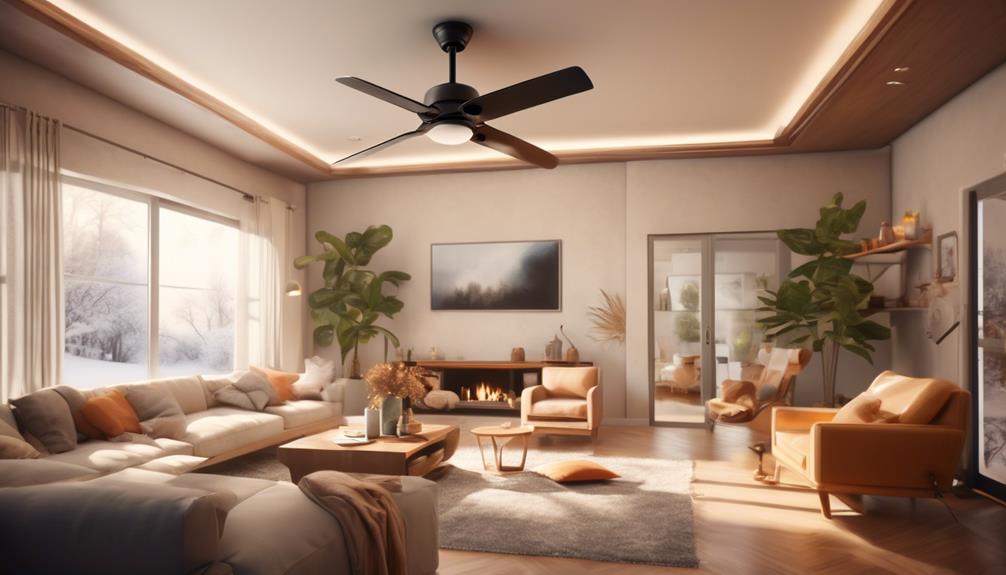
The reverse switch on a ceiling fan allows for the adjustment of the fan's direction, making it a valuable tool for optimizing comfort and energy efficiency throughout the year.
By utilizing the reverse switch, you can take advantage of the benefits of reverse airflow. During the warmer months, setting the fan to spin counterclockwise creates a cooling breeze, similar to the natural wind. This helps to create a wind-chill effect, making you feel cooler without actually lowering the temperature in the room. It also aids in better air circulation, reducing the reliance on air conditioning and saving energy.
In the colder months, using the reverse switch to set the fan to spin clockwise can help distribute warm air that tends to accumulate near the ceiling. This upward flow of air pushes the warmer air trapped at the top of the room down towards the floor, improving overall heating efficiency. As a result, your heating system won't have to work as hard to keep the room warm, potentially leading to energy savings.
To make the most of your ceiling fan's reverse switch, here are a few tips. During summer, set the fan to spin counterclockwise at a higher speed to create a cooling effect. In winter, set the fan to spin clockwise at a lower speed to gently push warm air down. Remember to adjust the fan's speed and direction based on your comfort needs and the room size.
Tips for Maximizing the Reverse Switch Functionality

To maximize the functionality of the reverse switch on your ceiling fan, there are several key tips and techniques to keep in mind:
- Adjust the fan speed: When using the reverse switch during the winter months, it's important to set the fan speed to its lowest setting. This will help to circulate warm air that rises to the ceiling, effectively maximizing airflow and redistributing heat throughout the room.
- Use the reverse switch strategically: Depending on the layout of your room, you may want to consider using the reverse switch only in certain areas. For example, if you have a seating area near a window, you can direct the airflow towards that area to create a comfortable and cozy space.
- Combine with other heating methods: While the reverse switch can help to maximize airflow and distribute warm air, it shouldn't be relied upon as the sole heating source in your home. To optimize energy consumption, consider using the reverse switch in conjunction with other heating methods, such as a fireplace or space heater.
- Clean and maintain regularly: To ensure optimal performance, it's important to clean and maintain your ceiling fan regularly. Dust and debris can accumulate on the blades, reducing airflow and efficiency. By keeping your fan clean, you can maximize its airflow capabilities and optimize energy consumption.
What is the Purpose of the Reverse Switch on Ceiling Fans?
The ceiling fans reverse usage benefits go beyond just cooling a room. The purpose of the reverse switch on ceiling fans is to create a gentle updraft, which helps to distribute warm air more evenly throughout the space during the winter months. This can ultimately help reduce heating costs and make the room more comfortable.
Frequently Asked Questions
Can I Use the Reverse Switch on My Ceiling Fan to Cool Down a Room in the Summer?
Yes, we can definitely use the reverse switch on our ceiling fan to cool down a room in the summer. By setting the fan to spin in the opposite direction, it creates a downdraft that circulates the air and creates a cooling effect.
This is particularly advantageous during hot summer months as it helps to distribute the cool air from your air conditioning system more evenly throughout the room, providing enhanced comfort and energy efficiency.
Does Using the Reverse Switch on My Ceiling Fan Save Energy in the Winter?
Using the reverse switch on our ceiling fans during winter can actually help save energy. By changing the direction of the fan blades, we can effectively distribute warm air that tends to rise, resulting in more even heating throughout the room.
This allows us to lower the thermostat temperature without sacrificing comfort, ultimately reducing energy consumption. It's a smart and efficient way to control the temperature in our homes while minimizing our environmental impact.
How Does Changing the Direction of the Fan Affect the Airflow in a Room?
Changing the fan direction has a significant impact on the airflow in a room and can affect the room temperature.
When the fan rotates in a counterclockwise direction, it creates a cooling effect by creating a breeze that evaporates moisture from our skin.
Conversely, when the fan rotates in a clockwise direction, it helps distribute warm air throughout the room by pushing it down from the ceiling.
This change in direction can effectively regulate the temperature in the room, providing comfort and energy efficiency.
What Are the Benefits of Using the Reverse Switch on a Ceiling Fan for Vaulted Ceilings?
The reverse switch on a ceiling fan offers several benefits for vaulted ceilings.
By using the reverse switch, you can direct the airflow upwards, which helps to circulate warm air that tends to rise and collect near the ceiling. This can result in more efficient heating during colder months.
Additionally, the reverse switch can create a gentle breeze effect in the room, providing a cooling sensation without the need for air conditioning.
Can Using the Reverse Switch on My Ceiling Fan Improve the Air Quality in My Home?
Using the reverse switch on your ceiling fan can indeed improve the air quality in your home. By reversing the direction of the fan blades, you can enhance ventilation and reduce allergens.
This is because the reverse switch creates an upward airflow, which helps to circulate and distribute the air more effectively. As a result, stagnant air, dust particles, and other allergens are less likely to accumulate in your living space, leading to a fresher and healthier environment.
Conclusion
In conclusion, the reverse switch on ceiling fans plays a vital role in improving air circulation, energy efficiency, and overall comfort in both summer and winter seasons.
By simply changing the direction of the fan blades, you can experience a cooling effect during hot days and distribute warm air evenly during colder months.
For example, imagine coming home from a long winter day to a cozy living room where the reverse switch is set to circulate warm air from your fireplace, creating a comforting and inviting atmosphere.
- About the Author
- Latest Posts
Introducing Ron, the home decor aficionado at ByRetreat, whose passion for creating beautiful and inviting spaces is at the heart of his work. With his deep knowledge of home decor and his innate sense of style, Ron brings a wealth of expertise and a keen eye for detail to the ByRetreat team.
Ron’s love for home decor goes beyond aesthetics; he understands that our surroundings play a significant role in our overall well-being and productivity. With this in mind, Ron is dedicated to transforming remote workspaces into havens of comfort, functionality, and beauty.
Garage Door Opener
Craftsman Garage Door Opener Battery Backup Installation Guide
Dive into the essential steps for installing the Craftsman Garage Door Opener Battery Backup to safeguard your garage access in critical moments.

Let’s address the installation of the Craftsman Garage Door Opener Battery Backup in a systematic manner.
As we navigate through the intricacies of setting up this essential backup system, we'll uncover key insights that can make all the difference in ensuring a seamless integration.
Stay tuned as we unravel the nuances of this process, shedding light on crucial steps that could be the game-changer in safeguarding your garage access during unforeseen situations.
Key Takeaways
- LED lights indicate battery status for seamless operation
- Replacement batteries available for around $90 from Sears
- Troubleshooting may involve battery replacement for functionality
- Understanding system intricacies crucial for uninterrupted operation
Battery Backup System Overview
When considering the Battery Backup System Overview for the Craftsman garage door opener, it's essential to understand its fundamental role in ensuring uninterrupted operation during power outages. The battery backup system is a crucial component of the Craftsman garage door opener, providing power during outages to maintain continuous functionality.
LED lights on the opener display different colors to indicate the battery status, with green signaling normal operation and red indicating error detection. This feature significantly enhances the reliability and performance of the garage door opener, especially during power disruptions.
Sears offers replacement batteries specifically designed for the Craftsman garage door opener, with replacements typically priced around $90. Troubleshooting the battery backup system may involve replacing the battery if indicated as faulty, following Sears' installation guidance to ensure proper functioning.
Understanding the intricacies of the battery backup system is vital for ensuring the seamless operation of the Craftsman garage door opener during power outages.
Required Tools and Materials

To successfully install the Craftsman garage door opener battery backup, gather essential tools such as a screwdriver, ladder, and possibly a drill for mounting, along with specific materials like the battery backup unit, mounting brackets, screws, and wiring harness. When preparing for the installation, it's crucial to ensure you have the following tools and materials ready:
- Screwdriver: Necessary for removing panels and securing components during the installation process.
- Ladder: Used to access and work on the garage door opener system safely at elevated heights.
- Drill: Optional but may be needed for mounting the battery backup unit securely in place.
- Mounting Brackets, Screws, and Wiring Harness: These are essential components for attaching the battery backup unit to the garage door opener and connecting it effectively.
Before beginning the installation, always prioritize safety precautions by disconnecting power sources and following the manufacturer's guidelines meticulously to prevent any accidents.
Step-by-Step Installation Instructions
Let's begin with the step-by-step installation instructions for integrating the Craftsman Garage Door Opener battery backup system. Follow these detailed steps to ensure a smooth installation process:
Craftsman Garage Door Opener Battery Backup Installation Steps:
| Steps | Actions | Tips |
|---|---|---|
| Step 1 | Turn off the power to the garage door opener. | Ensure safety by disconnecting the power source. |
| Step 2 | Locate the motor unit of the garage door opener. | The backup battery will be connected here. |
| Step 3 | Connect the backup battery to the motor unit. | Follow the provided instructions for proper installation. |
| Step 4 | Check the LED lights on the opener to verify battery status. | Green light indicates full charge; red light signals low battery. |
| Step 5 | Test the garage door opener with the backup battery. | Ensure seamless functionality during a power outage. |
Testing and Troubleshooting

We'll now proceed to assess the functionality of the Craftsman Garage Door Opener battery backup system through a series of tests and troubleshooting procedures.
- Check LED Lights: Look at the LED lights on the garage door opener. Green indicates normal operation, yellow signals backup power engagement, and red suggests an error requiring service.
- Test Keypad Codes: Ensure you're using the correct keypad codes for both the wall mount opener and the remote to operate the garage door.
- Inspect Trolley Engagement: If the trolley disengages due to power loss, re-engage it according to the manufacturer's instructions.
- Red Light Indicator: If the red light persists after troubleshooting, contact a professional for service on the garage door opener.
Maintenance Tips and Safety Precautions
Inspecting and lubricating the moving parts regularly ensures smooth operation and extends the longevity of your Craftsman Garage Door Opener. To maintain optimal performance and safety, keep the photo-eye sensors clean and properly aligned for the safety reversal system to function correctly. Periodically test the battery backup system to ensure it is ready for any power outages. Check for any loose hardware and tighten as needed to prevent accidents or malfunctions. It is essential to schedule professional maintenance at least once a year to address any potential issues and ensure the garage door opener operates efficiently.
| Maintenance Tips and Safety Precautions | ||
|---|---|---|
| 1. Inspect and lubricate moving parts | 2. Clean and align photo-eye sensors | 3. Test battery backup system |
| Regular inspection and lubrication keep the garage door opener running smoothly. | Ensure sensors are clean and aligned for proper safety function. | Verify battery backup readiness for power outages. |
| 4. Check for loose hardware | 5. Schedule professional maintenance | |
| Tighten any loose hardware to prevent accidents. | Annual maintenance ensures optimal performance. |
Frequently Asked Questions
How Do You Replace a Craftsman Garage Door Opener Battery?
We start by replacing a Craftsman garage door opener battery by checking the LED lights for status:
- Green for normal,
- Yellow for backup,
- Red for error.
We then proceed to purchase a replacement battery for about $90. We can find these batteries and installation guidance from Sears.
Common issues that may signal the need for battery replacement include:
- Trouble closing the door,
- Specific keypad codes,
- Trolley disengagement,
- A red service light.
Can You Add a Battery Backup to an Existing Garage Door Opener?
Yes, we can add a battery backup to an existing garage door opener. It's a simple upgrade that ensures seamless operation during power outages.
How Do You Install a Garage Backup Battery?
When installing a garage backup battery, we begin by ensuring the power is disconnected for safety.
Then, locate the designated terminals on the garage door opener and securely mount the battery.
Connect the battery to the terminals following the manufacturer's instructions carefully.
Test the backup battery regularly to confirm it's charged and ready to provide power during outages.
This will ensure uninterrupted operation of the garage door opener when needed.
Is Garage Door Opener Battery Backup Worth It?
Absolutely, having a garage door opener battery backup is totally worth it! It ensures continuous access to your garage, even during power outages, offering both convenience and security.
With seamless operation and no manual intervention required, the peace of mind it provides is priceless. The investment in a battery backup system for your garage door opener is a smart choice for anyone seeking uninterrupted accessibility in emergency situations.
Conclusion
In conclusion, installing a Craftsman garage door opener battery backup is a smart investment for ensuring your garage door operates smoothly even during power outages.
Did you know that 70% of homeowners experience at least one power outage every year? By following the step-by-step guide provided, you can easily set up your battery backup system and enjoy peace of mind knowing your garage door will always be functional.
- About the Author
- Latest Posts
Introducing Ron, the home decor aficionado at ByRetreat, whose passion for creating beautiful and inviting spaces is at the heart of his work. With his deep knowledge of home decor and his innate sense of style, Ron brings a wealth of expertise and a keen eye for detail to the ByRetreat team.
Ron’s love for home decor goes beyond aesthetics; he understands that our surroundings play a significant role in our overall well-being and productivity. With this in mind, Ron is dedicated to transforming remote workspaces into havens of comfort, functionality, and beauty.
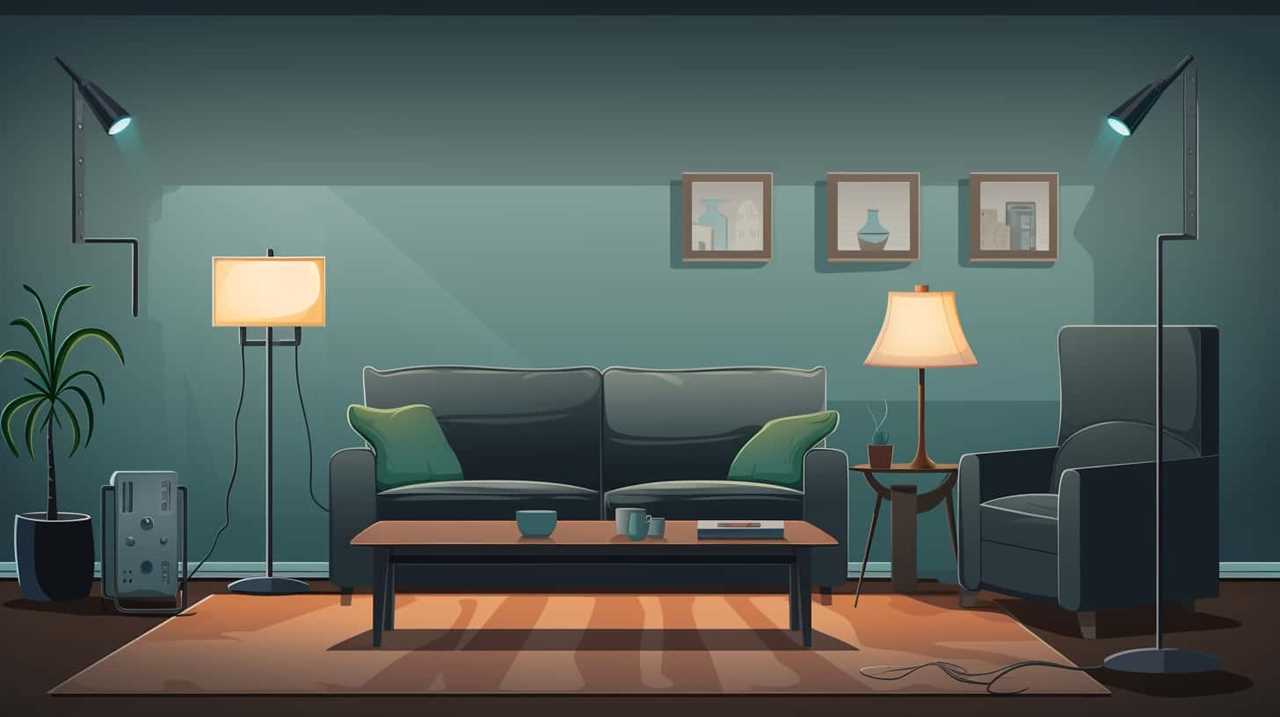
In the realm of cooking, we understand the importance of having the proper tools at your disposal. Just like the saying, ‘a chef’s skills are only as good as their equipment.’ That’s why we have compiled a list of 10 clever kitchen gadgets that every home cook should have.
These innovative devices are designed to elevate your cooking experience and bring a touch of mastery to your culinary creations. From a smart refrigerator with a touchscreen display to a voice-controlled smart oven, these gadgets combine functionality and convenience in ways you never thought possible.
So, let’s dive in and discover the game-changing gadgets that are about to revolutionize your kitchen.
Key Takeaways
- Smart kitchen gadgets for coffee lovers offer customizable brewing options and remote brewing capabilities, making the coffee brewing process simplified and enhanced.
- Smart kitchen gadgets for precision cooking, such as smart sous vide precision cookers and programmable pressure cookers, ensure consistent and precise cooking results without constant monitoring.
- Smart kitchen gadgets for meal planning and organization, like app-controlled slow cookers and blenders, save time in monitoring and controlling the cooking process and make grocery shopping and meal preparation more efficient.
- Smart kitchen gadgets enhance cooking skills by elevating the home brewing and cooking experience to a professional level, ensuring recipe accuracy and consistency, and allowing for customization of cooking settings based on personal preferences.
Smart Refrigerator With Touchscreen Display
Our favorite feature of the smart refrigerator is its touchscreen display, which allows us to easily access and organize our groceries. With the integration of touchscreen technology, this interactive kitchen appliance revolutionizes the way we manage our food inventory.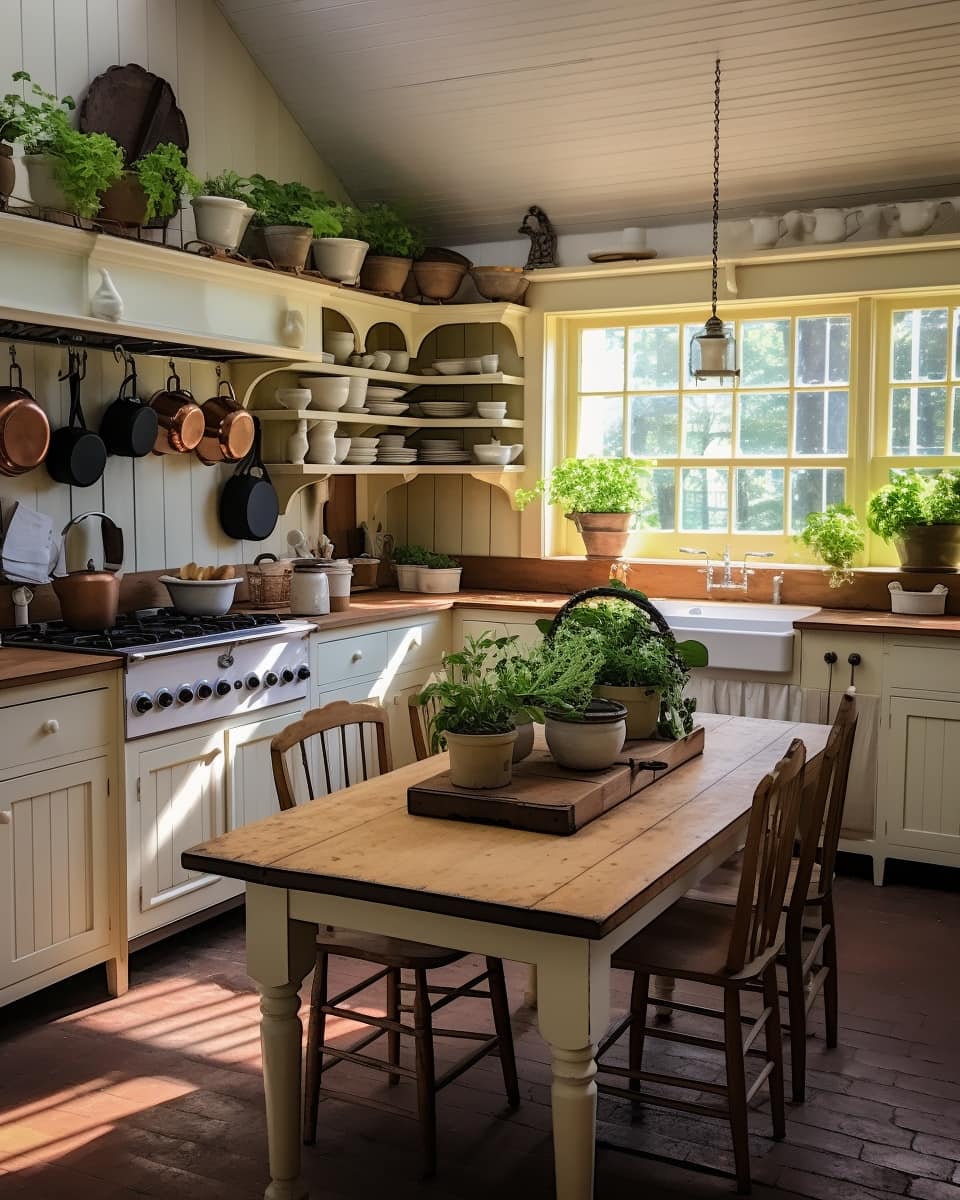
The touchscreen display provides a user-friendly interface that enables us to effortlessly navigate through the refrigerator’s various features and functions. We can view our groceries at a glance, making it convenient to check what items we’ve and what needs to be restocked. The display also allows us to create shopping lists directly on the screen, ensuring that we never forget an essential ingredient again.
Furthermore, the interactive nature of the touchscreen allows us to customize settings according to our preferences. We can adjust temperature controls, select specific storage zones for different food items, and even set expiration reminders to minimize food waste. The smart refrigerator also offers recipe suggestions based on the ingredients available, making meal planning easier and more efficient.
In terms of design, the touchscreen display seamlessly blends with the aesthetics of the refrigerator, enhancing the overall visual appeal of our kitchen. Its intuitive interface and sleek appearance make it a desirable addition to any modern home.
Voice-Controlled Smart Oven
We love using our voice-controlled smart oven to effortlessly cook our favorite meals. This innovative kitchen gadget combines the convenience of voice control with advanced automation features, making it an essential tool for any home chef. With just a simple voice command, we can easily preheat the oven, adjust the temperature, set timers, and even check the cooking progress without lifting a finger.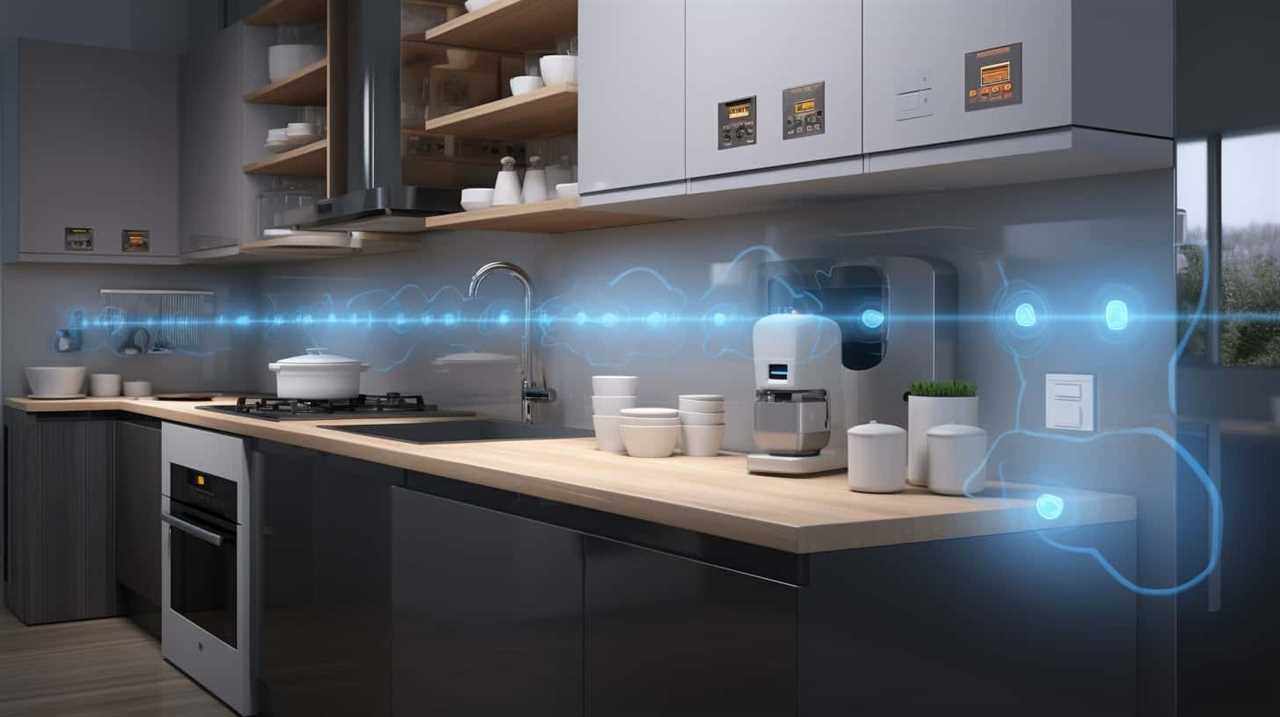
The automation benefits of a voice-controlled oven are truly remarkable. It saves us time and effort by eliminating the need to manually operate the oven. We can multitask in the kitchen or attend to other chores while our meal bakes to perfection. The table below highlights some of the key features and advantages of a voice-controlled smart oven:
| Features | Advantages |
|---|---|
| Voice control | Hands-free operation for a seamless cooking experience |
| Temperature control | Precise heat adjustment for consistent results |
| Timer setting | Set timers and receive alerts for perfect timing |
A voice-controlled smart oven takes cooking to a whole new level of convenience and efficiency. It empowers us to effortlessly create delicious meals while enjoying the benefits of automation. Whether we are busy professionals or culinary enthusiasts, this smart kitchen gadget is a must-have for those who seek mastery in the art of cooking.
Wi-Fi Enabled Smart Coffee Maker
We all know that a good cup of coffee is essential to kickstart our day. A Wi-Fi enabled smart coffee maker can take our coffee experience to the next level. With the benefits of automation, we can wake up to the aroma of freshly brewed coffee without lifting a finger.
But that’s not all – the remote brewing capabilities allow us to start brewing our coffee from anywhere in our home. This ensures that our cup of joe is ready when we need it.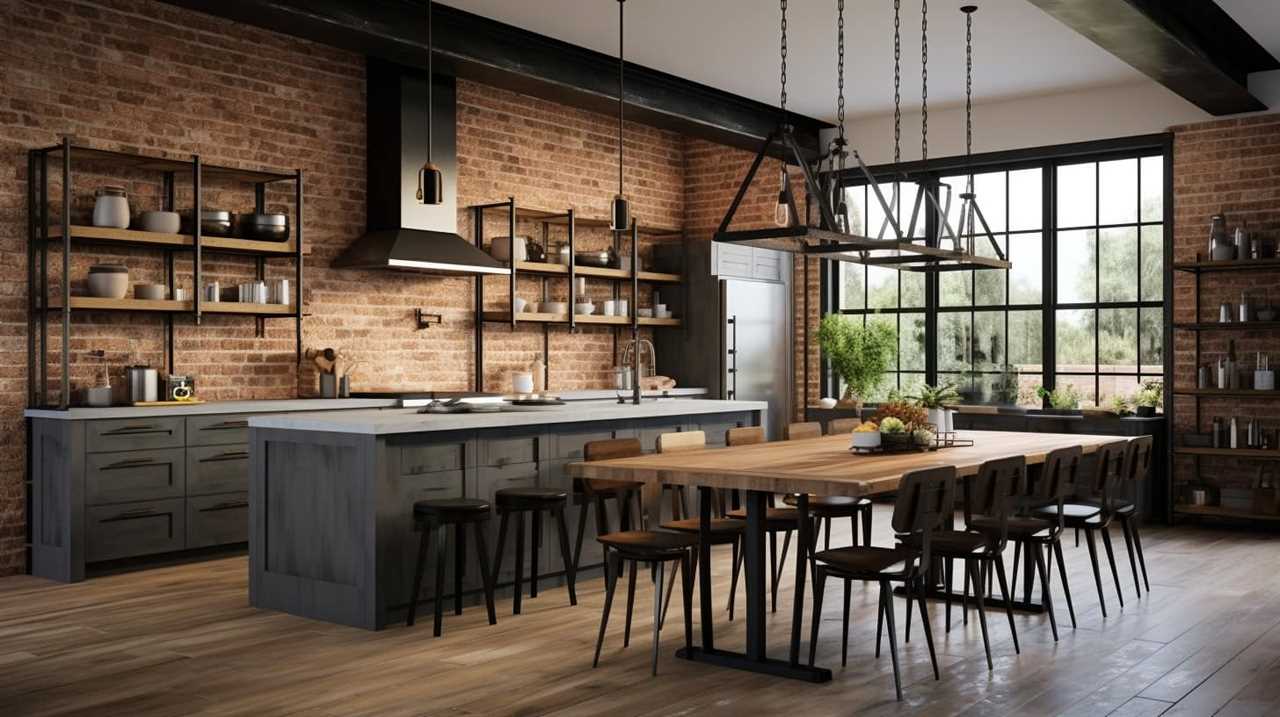
And with customizable brewing options, we can personalize our coffee strength and flavor to suit our preferences.
Benefits of Automation
The convenience of automation is one of the key advantages offered by a Wi-Fi enabled smart coffee maker. With this innovative gadget, you can easily set your coffee to start brewing at a specific time, ensuring you wake up to the aroma of freshly brewed coffee.
Here are some benefits of automation in the kitchen:
- Time-saving: Automation allows you to focus on other tasks while your coffee maker takes care of brewing your favorite cup of joe.
- Customization: With a smart coffee maker, you can easily adjust the strength, temperature, and even the size of your coffee, ensuring it perfectly suits your preferences.
Automation in the kitchen, such as a Wi-Fi enabled smart coffee maker, is just one example of how technology has impacted cooking skills. It simplifies and enhances the coffee brewing process, giving home chefs more control and convenience.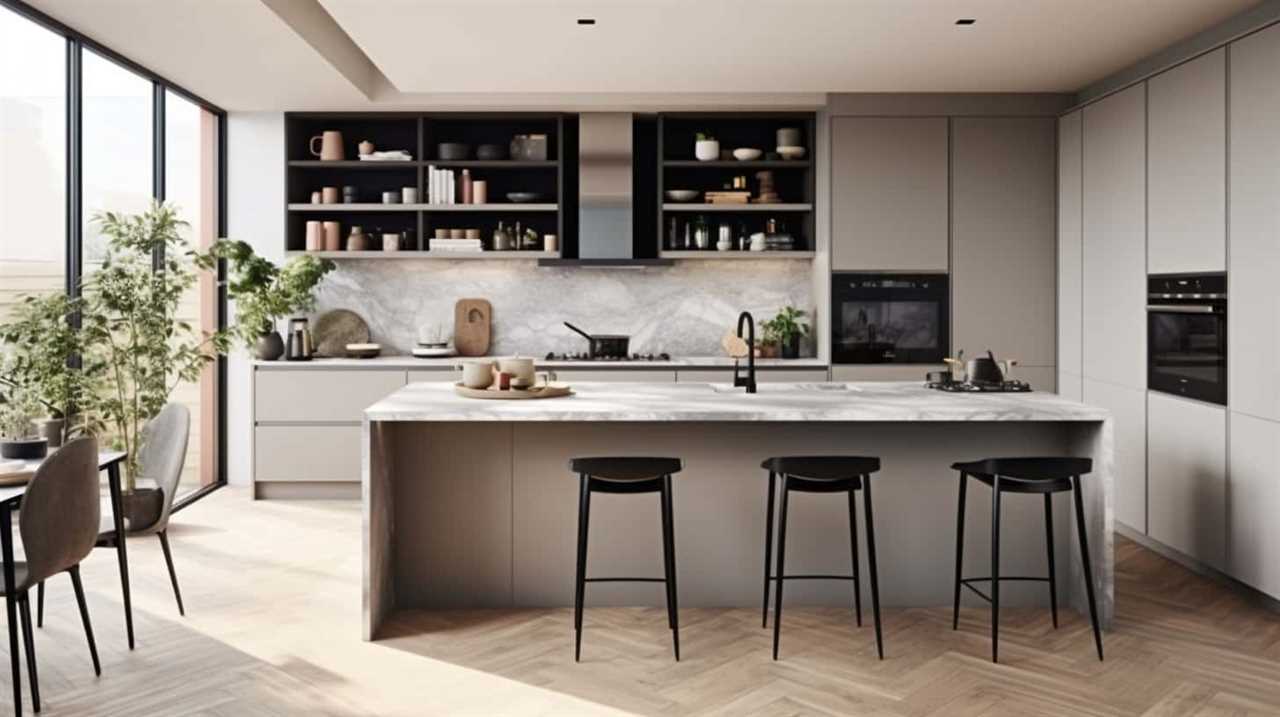
As technology continues to evolve, we can expect even more innovative gadgets that will revolutionize the way we cook and enjoy our meals.
Remote Brewing Capabilities
Using the convenience of a time preposition, our smart coffee maker allows us to remotely brew a perfect cup of coffee from anywhere in the house. Imagine waking up in the morning and being able to start brewing your favorite cup of joe without even leaving your bed. With customizable recipes and remote temperature control, our smart coffee maker provides the ultimate brewing experience.
Take a look at the table below to see the features of our Wi-Fi enabled smart coffee maker:
| Feature | Description |
|---|---|
| Customizable Recipes | Create and save your own coffee recipes with different brewing parameters such as strength, grind size, and water temperature. |
| Remote Temperature Control | Adjust the temperature of your brew remotely, ensuring that you have the perfect cup of coffee every time. |
| Brew Scheduling | Set a schedule for your coffee maker to start brewing automatically, so you can wake up to a fresh pot of coffee every morning. |
| Notifications | Receive notifications on your smartphone when your coffee is ready or when the water reservoir needs to be refilled. |
| Compatibility | Our smart coffee maker is compatible with popular voice assistants, allowing you to control it with simple voice commands. |
With these features, our smart coffee maker revolutionizes the way you brew coffee, giving you full control and convenience right at your fingertips.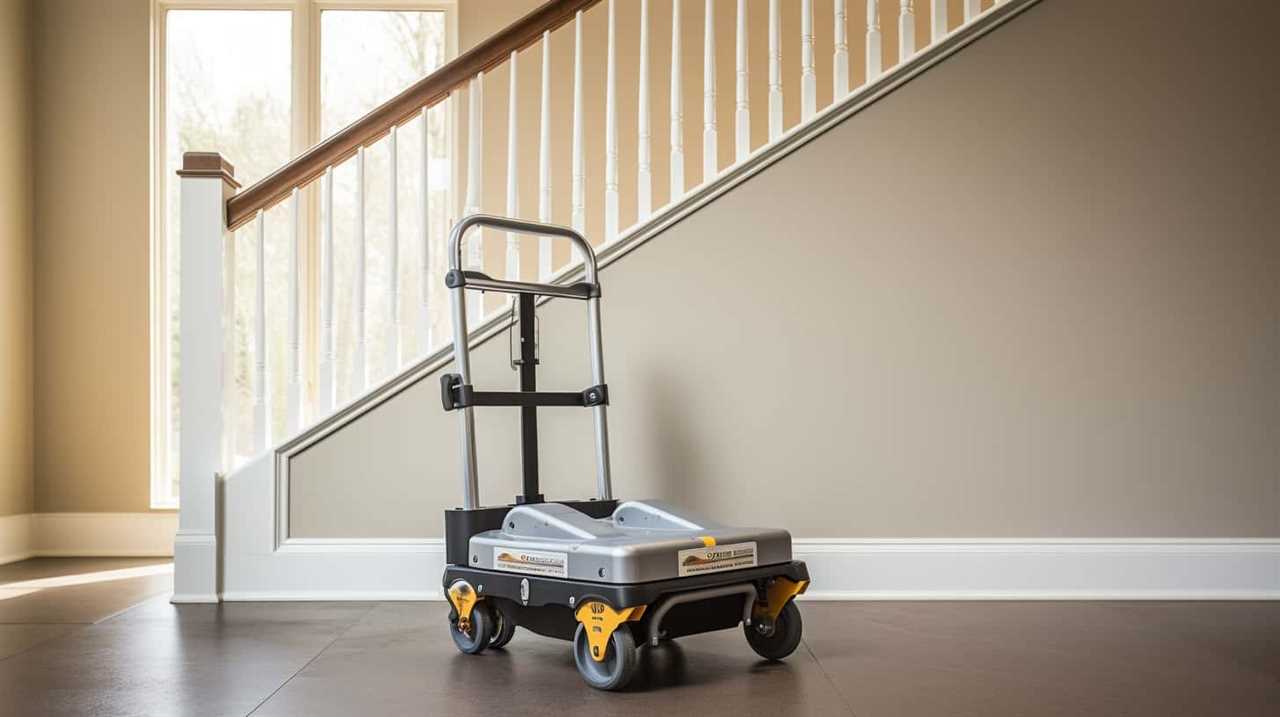
Customizable Brewing Options
Exploring the customizable brewing options of our Wi-Fi enabled smart coffee maker, we can create a personalized coffee experience with ease. With its remote brewing capabilities, this innovative kitchen gadget brings convenience and functionality to a whole new level.
Here’s what you can expect from our customizable brewing options:
- Adjustable Strength: Tailor the strength of your coffee to suit your taste preferences. Whether you prefer a bold and robust brew or a milder flavor, our smart coffee maker allows you to easily adjust the strength settings.
- Multiple Brewing Styles: From espresso to cappuccino, our coffee maker offers a variety of brewing styles. Experiment with different options to create your perfect cup of coffee.
With these customizable brewing options, you have complete control over your coffee-making process. Indulge in your favorite coffee creations and elevate your home brewing experience to a professional level. The possibilities are endless with our Wi-Fi enabled smart coffee maker.
Smart Food Scale With Recipe App Integration
One essential smart kitchen gadget that every home chef needs is a food scale that seamlessly integrates with recipe apps. This innovative device not only helps with portion control but also allows for accurate recipe tracking. With the integration of a recipe app, you can easily measure ingredients and keep track of your recipe progress all in one place.
Gone are the days of manually measuring ingredients with measuring cups and spoons. A smart food scale takes the guesswork out of cooking by providing precise measurements for ingredients. This ensures that your recipes come out perfectly every time. Whether you’re following a recipe from a cookbook or experimenting with your own creations, a food scale with recipe app integration is an invaluable tool in the kitchen.
The recipe tracking feature of this smart food scale allows you to keep track of the ingredients you have used and the ones you still need. It eliminates the need to manually cross off ingredients as you go, saving you time and preventing any missed or duplicated ingredients. This feature is especially helpful when cooking complex dishes with multiple components.
In addition to recipe tracking, a smart food scale with recipe app integration also provides portion control. It helps you measure the exact amount of each ingredient, ensuring that you’re following the recipe accurately and maintaining consistency in taste and texture. This is particularly useful for those who are watching their calorie intake or following specific dietary guidelines.
Smart Sous Vide Precision Cooker
Let’s dive into the next essential smart kitchen gadget: the smart sous vide precision cooker. This innovative device takes precision cooking to a whole new level. With its remote temperature control and cooking time optimization features, it revolutionizes the way you cook.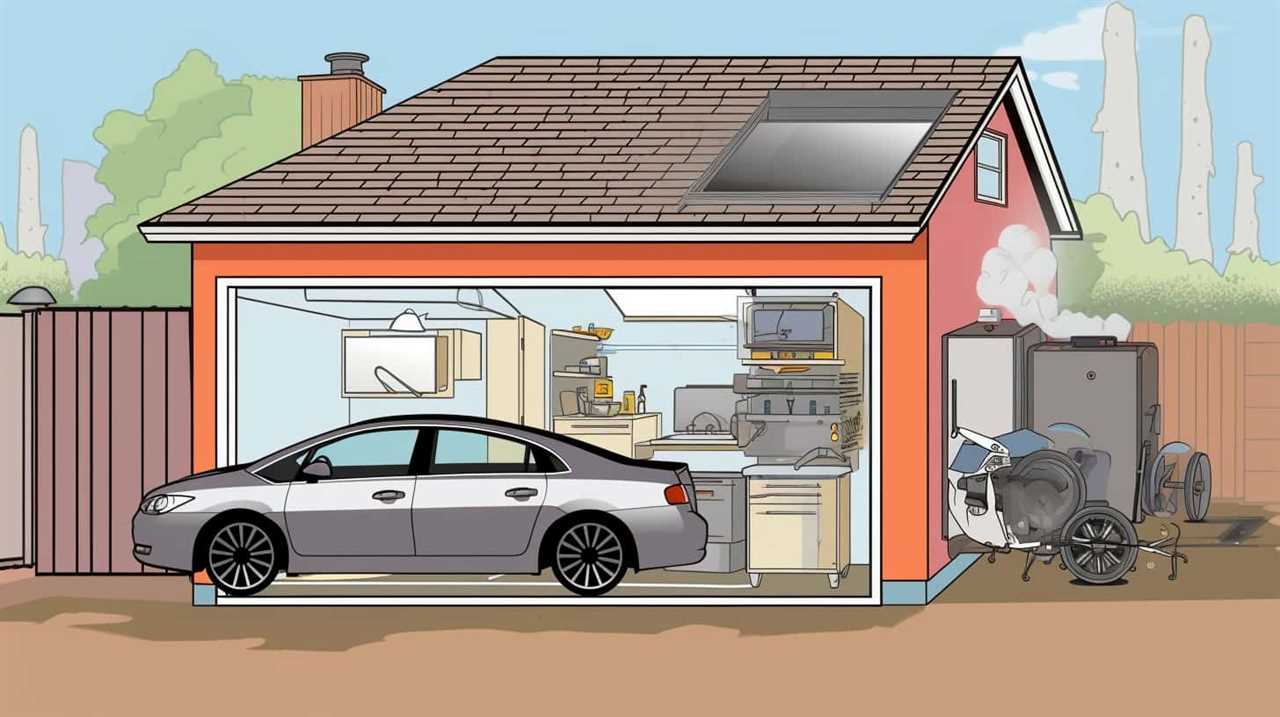
Imagine being able to control the temperature of your sous vide cooker from anywhere in your home. Whether you’re in the living room, taking care of other tasks, or simply relaxing on the couch, you can easily monitor and adjust the temperature with just a few taps on your smartphone. No more rushing back and forth to the kitchen to make sure everything is cooking perfectly.
But that’s not all. The smart sous vide precision cooker also helps optimize cooking times. By precisely controlling the water temperature and circulating it evenly around your food, it ensures that your ingredients are cooked to perfection every time. This means no more guesswork or overcooking. With the smart sous vide precision cooker, you can achieve restaurant-quality results in the comfort of your own kitchen.
Mastering the art of sous vide cooking has never been easier with this smart gadget. Say goodbye to the hassle of traditional cooking methods and embrace the convenience and precision of the smart sous vide precision cooker. Elevate your culinary skills and impress your guests with perfectly cooked dishes that will leave them wanting more.
Automated Stirrer for Hands-Free Cooking
An automated stirrer is an essential kitchen gadget that every home chef needs for hands-free cooking. This innovative device takes the hassle out of stirring, allowing you to focus on other tasks while your food is being perfectly mixed. Whether you’re making a sauce, soup, or a delicious risotto, the automated stirrer ensures even heat distribution and prevents sticking or burning.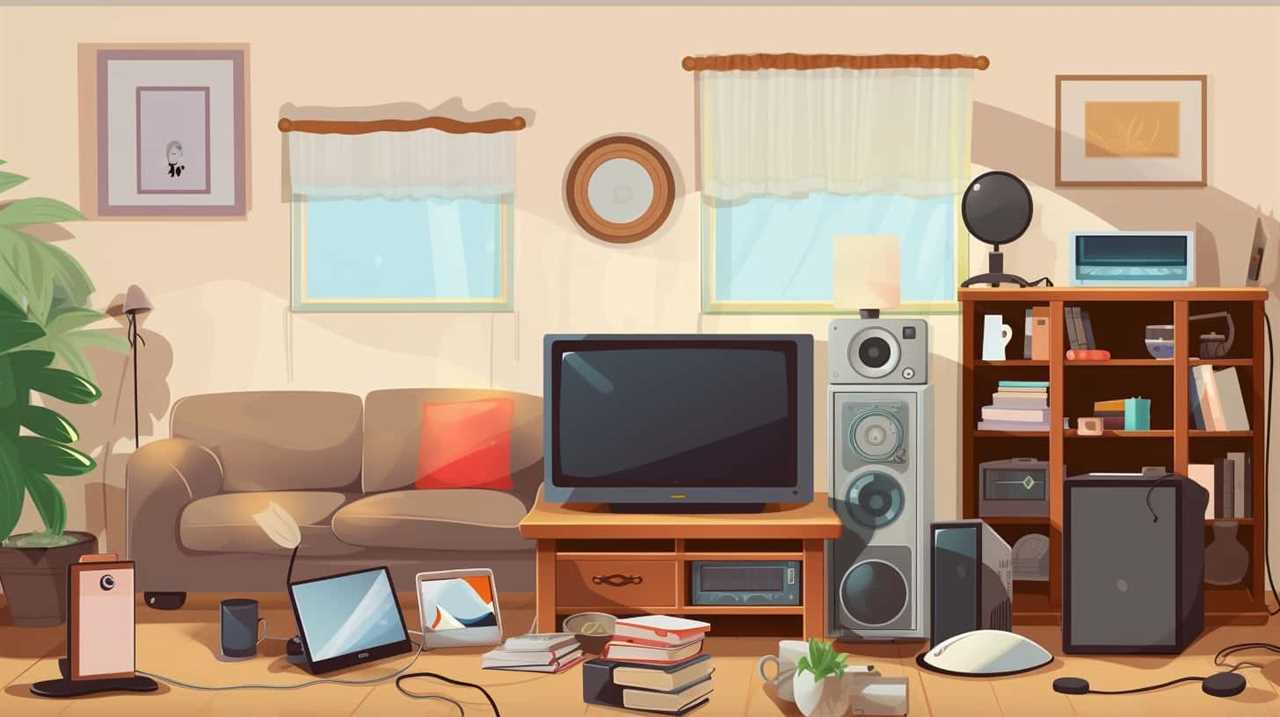
One popular option is the automated whisk, specifically designed for hands-free baking. With adjustable speed settings, it can effortlessly mix ingredients for cake batter, whipped cream, or meringues. Imagine being able to step away from the mixing bowl and let the whisk do all the work!
For those looking to take automation to the next level, a robotic chef for meal preparation is the ultimate kitchen companion. These advanced devices can chop, stir, and even cook your meals from start to finish. With pre-programmed recipes and precise temperature control, you can trust the robotic chef to create restaurant-quality dishes with minimal effort.
Investing in an automated stirrer or a robotic chef won’t only save you time and effort but also elevate your cooking game to the next level. Say goodbye to endless stirring and hello to hands-free cooking mastery!
Smart Air Fryer With Programmable Settings
Now let’s talk about the Smart Air Fryer with programmable settings.
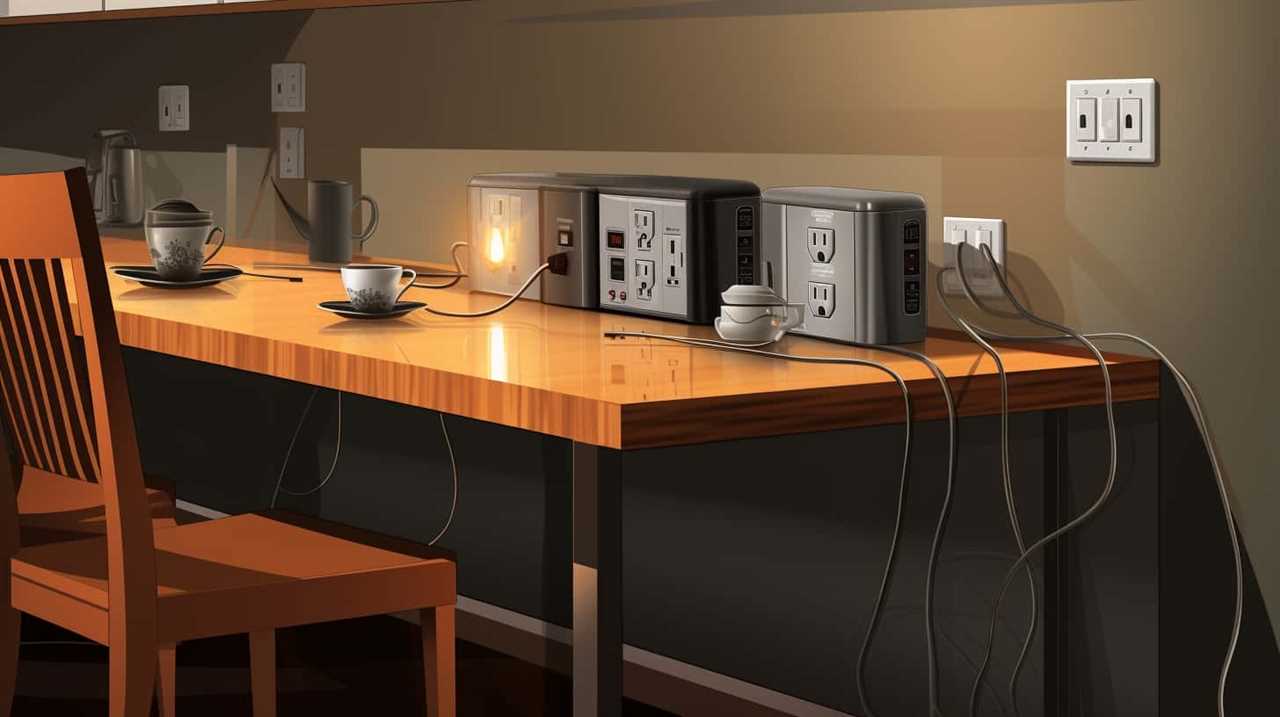
This innovative kitchen gadget is a game-changer for home chefs looking to save time and enhance their cooking versatility.
With its time-saving cooking features and customizable settings, you can easily achieve crispy, delicious results without the need for excessive oil or complicated recipes.
Time-Saving Cooking Features
We love how our smart air fryer with programmable settings saves us time in the kitchen. With its automated meal planning feature, we can easily schedule our meals for the week and let the air fryer do the rest. It’s like having our own personal chef!
Additionally, the smart air fryer is compatible with smart meal delivery services, allowing us to receive pre-portioned ingredients directly to our doorstep. This means less time spent at the grocery store and more time doing what we love – cooking delicious meals.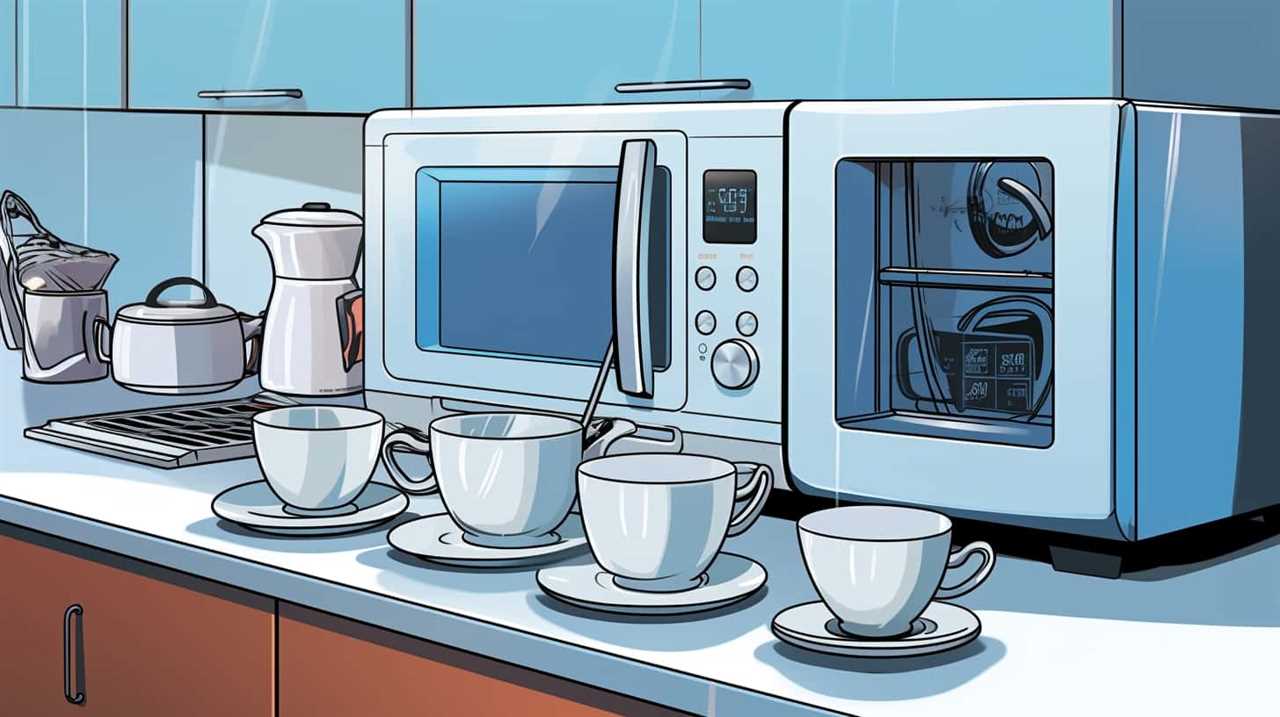
The programmable settings also ensure that our food is cooked to perfection every time, eliminating the need for constant monitoring.
Thanks to this incredible kitchen gadget, we can now enjoy convenient and time-saving cooking without compromising on taste and quality.
Enhanced Cooking Versatility
Our smart air fryer’s programmable settings enhance our cooking versatility. With these advanced features, we can achieve cooking efficiency and explore a wide range of advanced culinary techniques.
The programmable settings allow us to adjust the temperature and cooking time precisely, ensuring that our food is cooked to perfection every time. We can experiment with different cooking methods, from air frying to baking, roasting, and even dehydrating.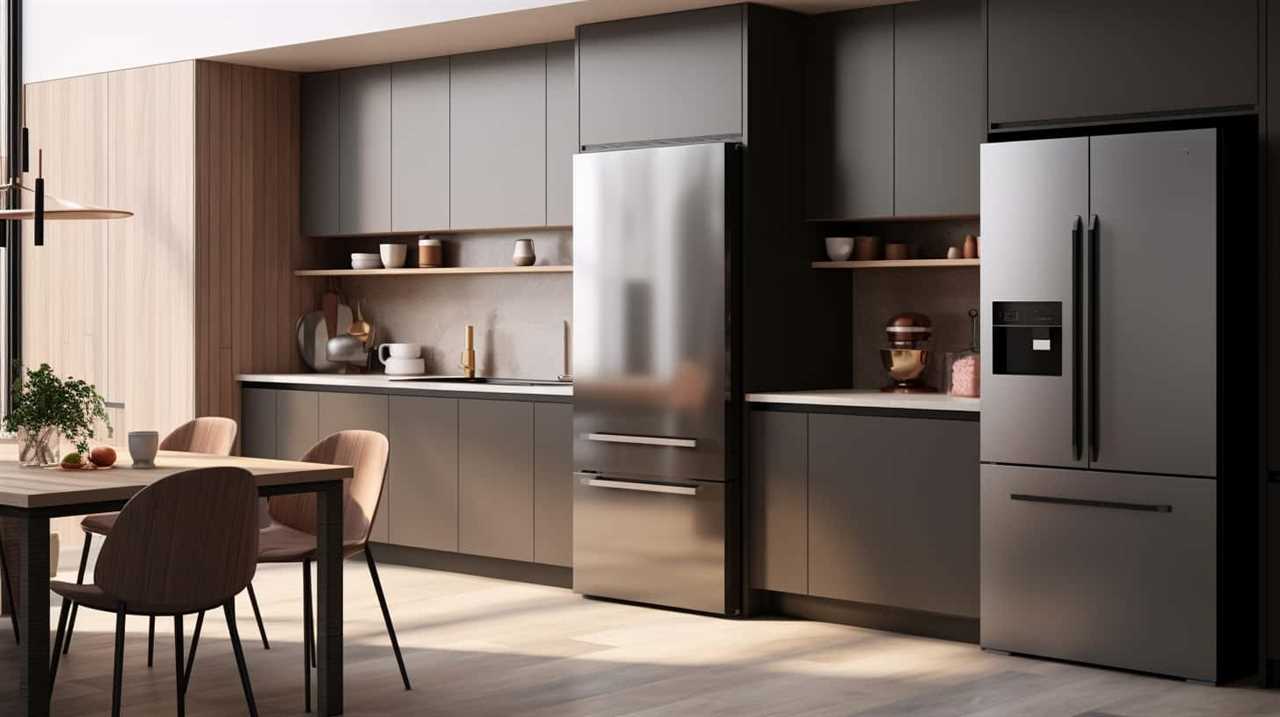
This versatility opens up a world of possibilities in the kitchen, allowing us to create healthier versions of our favorite fried foods or explore new recipes that require specific cooking techniques. Whether we want to cook crispy chicken wings, bake a batch of cookies, or even make homemade beef jerky, our smart air fryer with programmable settings is a must-have tool for any home chef looking to elevate their culinary skills.
Wi-Fi Connected Smart Blender
To streamline our kitchen experience, we incorporated a Wi-Fi connected smart blender into our culinary routine, allowing us to effortlessly blend ingredients with just a few taps on our smartphones. The benefits of blending remotely are numerous, and the integration of Wi-Fi connectivity in kitchen appliances has revolutionized the way we prepare our meals.
Here are some key advantages of this innovative gadget:
- Convenience: With a Wi-Fi connected smart blender, we can control and monitor the blending process from anywhere in our home. Whether we’re in the living room or outside in the garden, we can easily adjust the speed and duration of the blending to achieve the desired consistency.
- Time-saving: Gone are the days of standing by the blender, constantly checking and adjusting the settings. With the Wi-Fi connectivity feature, we can set the blender to start at a specific time, ensuring that our ingredients are perfectly blended when we’re ready to use them.
- Recipe suggestions: Many smart blenders come with companion apps that offer a wide range of recipes and blending techniques. These apps provide step-by-step instructions and even suggest ingredient combinations based on our preferences, making it easier than ever to experiment with new flavors and textures.
- Customization: Wi-Fi connected smart blenders allow us to save our favorite blending settings, creating a personalized library of recipes that can be accessed with a simple tap on our smartphones. This level of customization ensures consistency in our cooking and allows us to recreate our favorite blends effortlessly.
The integration of Wi-Fi connectivity in kitchen appliances, such as the smart blender, has undoubtedly enhanced our culinary experience. With the ability to blend remotely, save time, access recipe suggestions, and personalize our blending settings, this gadget has become an indispensable tool in our kitchen.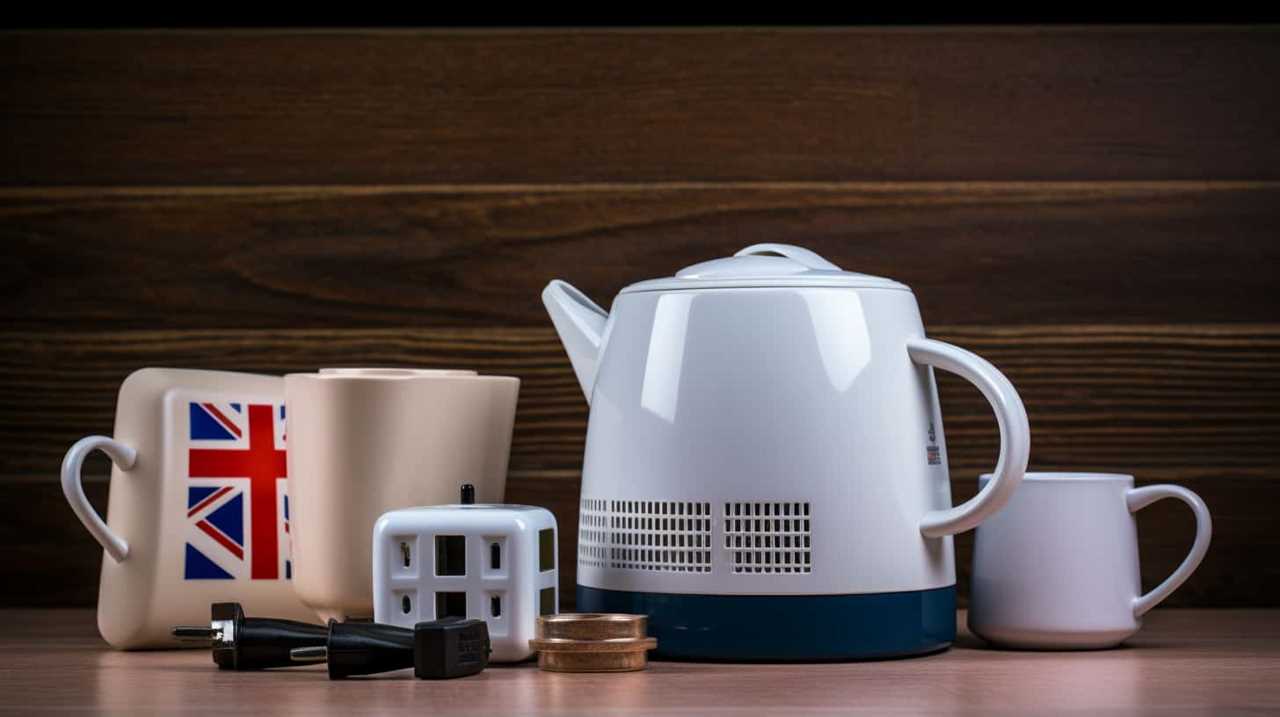
Smart Pressure Cooker With Multiple Cooking Modes
For maximum versatility in the kitchen, we rely on a smart pressure cooker with multiple cooking modes. This innovative kitchen gadget takes the guesswork out of pressure cooking by offering a range of preset cooking modes, each designed to deliver perfect results for different types of dishes. Whether you’re in the mood for a hearty stew, a tender roast, or a flavorful risotto, this smart pressure cooker has got you covered.
With its multiple cooking modes, you can easily select the perfect setting for your desired dish. From high-pressure mode for quick cooking, to low-pressure mode for delicate foods, this smart pressure cooker adapts to your cooking needs. It also offers modes for sautéing, steaming, and even yogurt making, giving you the ability to create a wide variety of dishes with just one appliance.
Not only does this smart pressure cooker offer convenience and versatility, but it also comes with advanced features that make cooking even easier. With its programmable timer and delay start function, you can set it to start cooking at a specific time, allowing you to come home to a delicious meal. Some models even come with built-in sensors that automatically adjust the cooking time and temperature to ensure perfect results every time.
Smart Slow Cooker With App-Controlled Features
When it comes to convenience in cooking, a smart slow cooker with app-controlled features is a game-changer. With the ability to control cooking settings and monitor progress right from your smartphone, meal preparation becomes a breeze.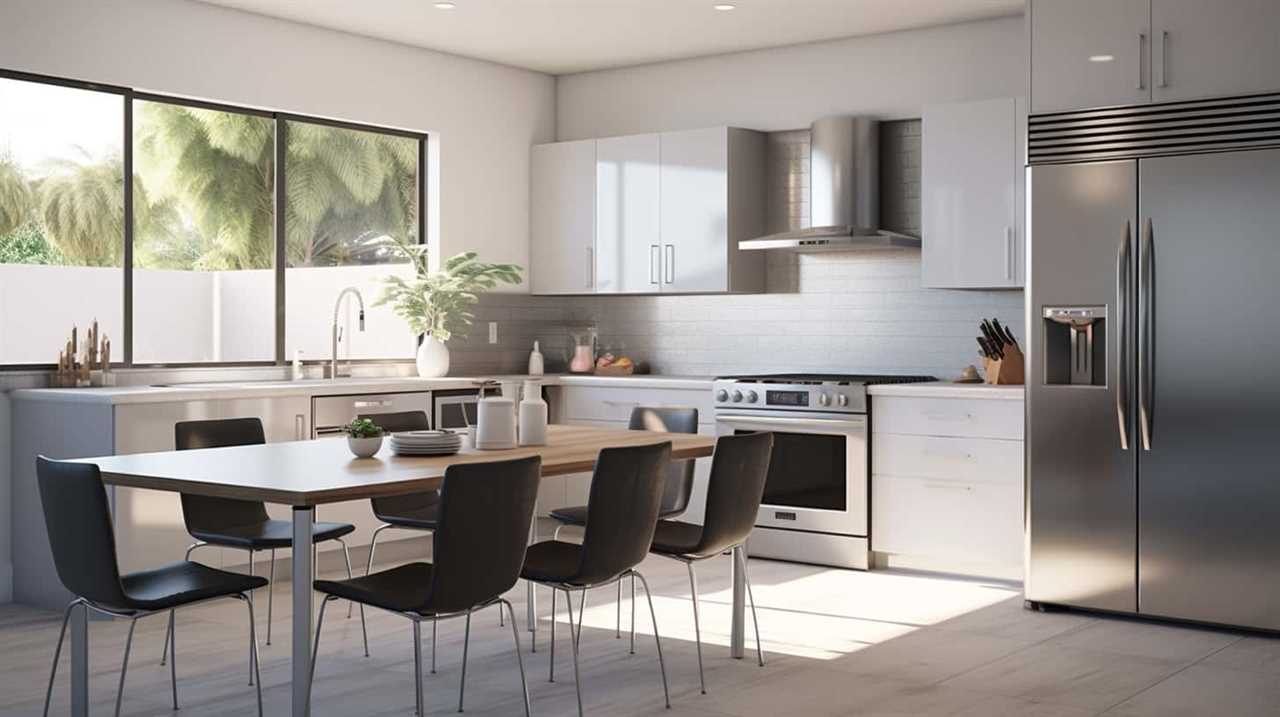
Not only does this save valuable time, but it also ensures enhanced cooking precision, allowing you to achieve perfect results every time.
App-Controlled Convenience for Cooking
With the use of an app-controlled smart slow cooker, we can easily enhance our cooking experience in the kitchen. This innovative gadget allows us to have app controlled meal delivery, ensuring that our meals are cooked to perfection even when we’re not in the kitchen.
The convenience of being able to monitor and control our slow cooker from anywhere using our smartphones is a game-changer. Additionally, this smart kitchen gadget contributes to smart kitchen organization by allowing us to plan our meals in advance and set timers remotely.
Imagine coming home to a perfectly cooked meal, with the aroma welcoming you at the door. This app-controlled convenience takes cooking to a whole new level, making it easier and more enjoyable for home chefs.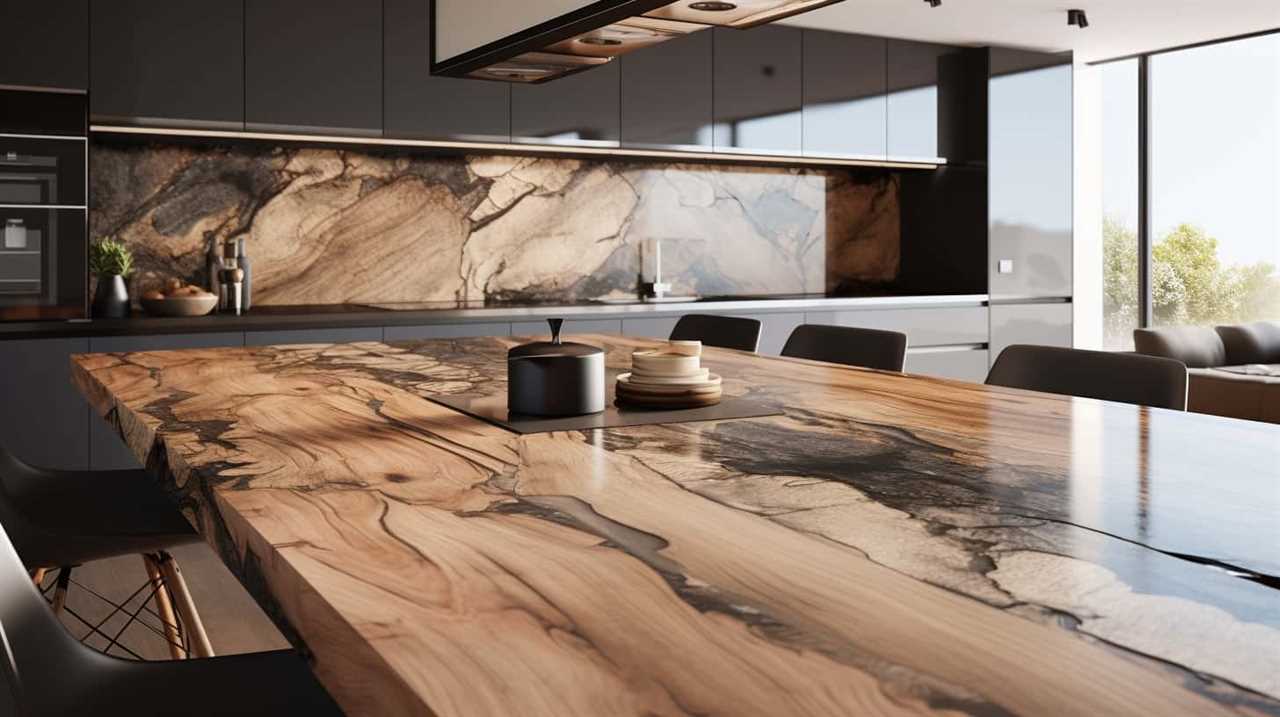
Now, let’s move on to the next section about time-saving meal preparation.
Time-Saving Meal Preparation
After experiencing the convenience of app-controlled meal delivery with our smart slow cooker, our time-saving meal preparation is taken to a new level. With the help of smart meal planning and efficient kitchen organization, we can now save significant amounts of time in the kitchen.
Our smart slow cooker comes with app-controlled features that allow us to monitor and control the cooking process from anywhere. We can easily adjust the temperature, cooking time, and even receive notifications when the meal is ready. This not only saves us time, but also ensures that our meals are cooked to perfection.
Additionally, the smart meal planning feature helps us plan our meals in advance, making grocery shopping and meal preparation more efficient. With these app-controlled features, we can now enjoy delicious homemade meals without spending hours in the kitchen.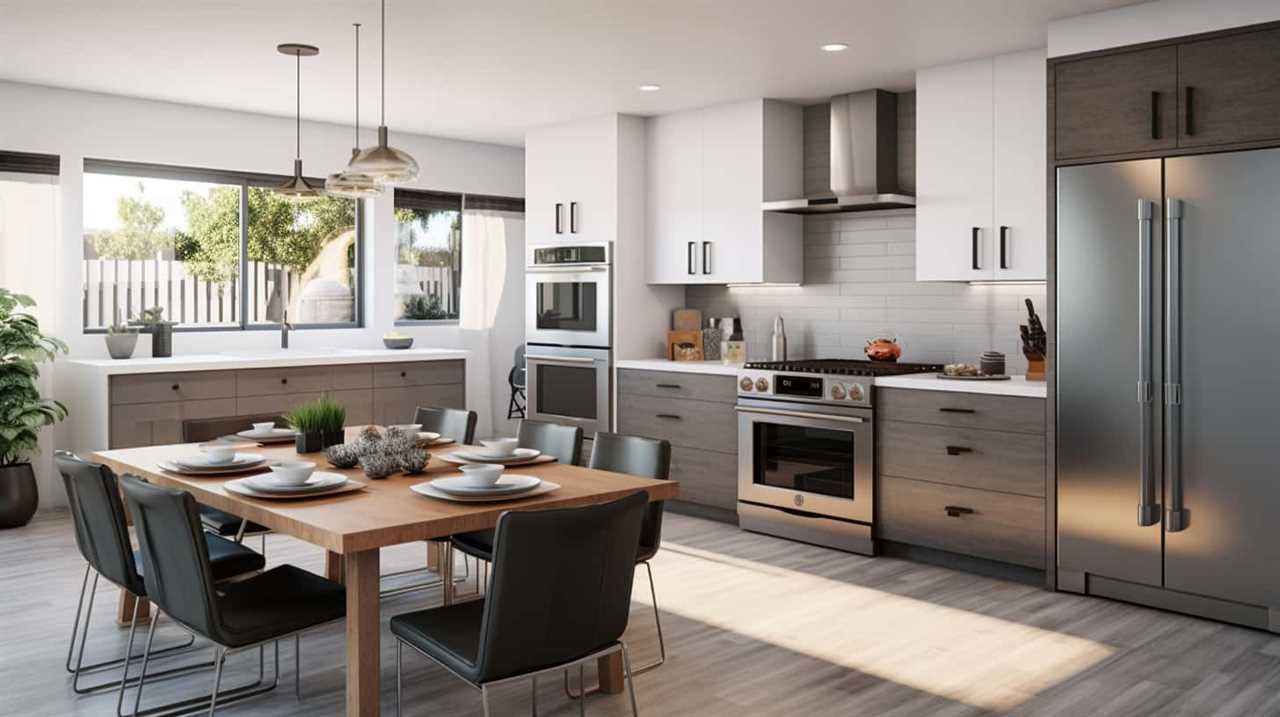
Enhanced Cooking Precision
Our smart slow cooker’s app-controlled features allow us to achieve enhanced cooking precision. With the ability to control the cooking temperature with pinpoint accuracy, we can ensure that our recipes turn out perfectly every time.
The app provides us with a range of cooking temperatures to choose from, allowing us to select the ideal setting for each dish. Whether we’re slow cooking a tender roast or simmering a flavorful soup, the smart slow cooker ensures that the temperature stays consistent throughout the entire cooking process.
This level of control not only guarantees recipe accuracy but also allows us to experiment and fine-tune our favorite dishes to perfection. With the app-controlled features of our smart slow cooker, we can elevate our cooking skills to a whole new level.
Frequently Asked Questions
How Do I Connect My Smart Refrigerator to My Home Wi-Fi Network?
Connecting a smart refrigerator to the home Wi-Fi network is a common concern for many users. In this blog post, we’ll guide you through the process and provide step-by-step instructions to ensure a seamless connection.
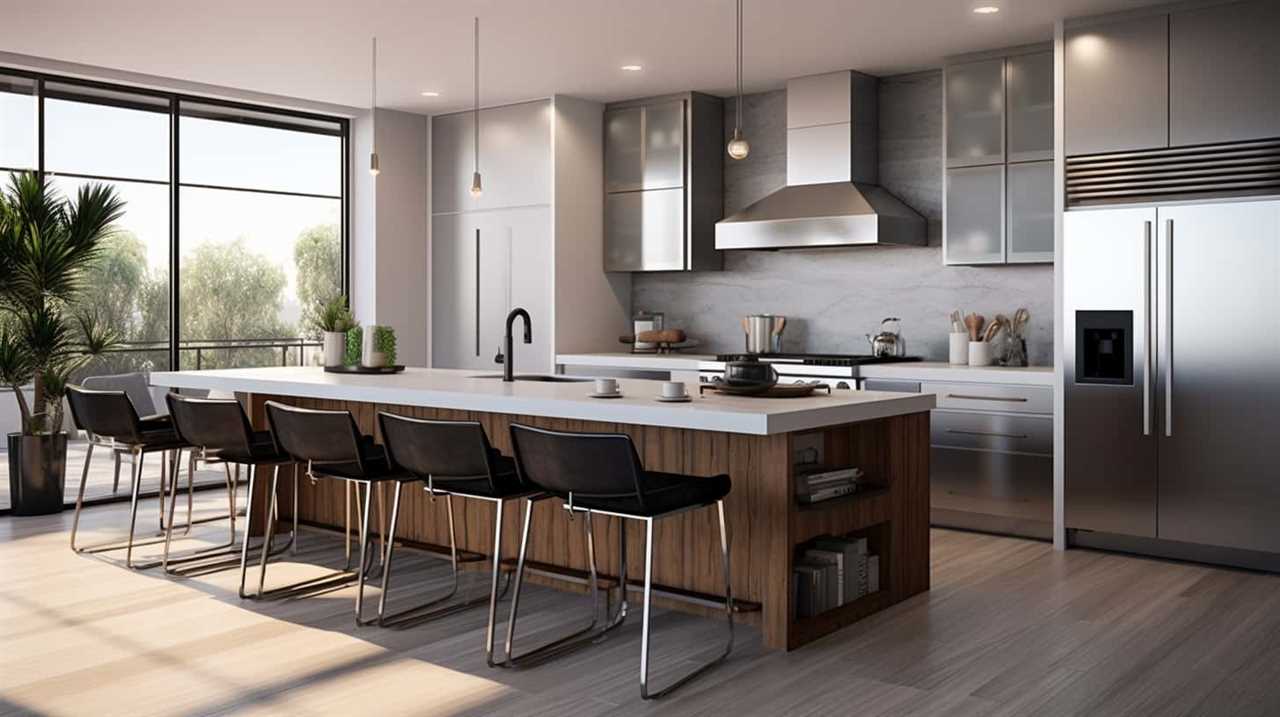
First, make sure your refrigerator is powered on and within range of your Wi-Fi router.
Then, access the settings menu on your refrigerator, navigate to the Wi-Fi section, and select your home network.
Enter your Wi-Fi password when prompted, and voila! Your smart refrigerator is now connected to your home Wi-Fi network.
Can the Voice-Controlled Smart Oven Be Controlled Remotely Through a Smartphone App?
Yes, the voice-controlled smart oven can be controlled remotely through a smartphone app.
Smart kitchen appliances, such as voice-controlled smart ovens, are revolutionizing the way we cook and making our lives easier.
With the smartphone app, you can preheat the oven, adjust the temperature, and set timers from anywhere.
This feature is especially handy for busy home chefs on the go.
Upgrade your kitchen gadgets with a voice-controlled smart oven for complete control at your fingertips.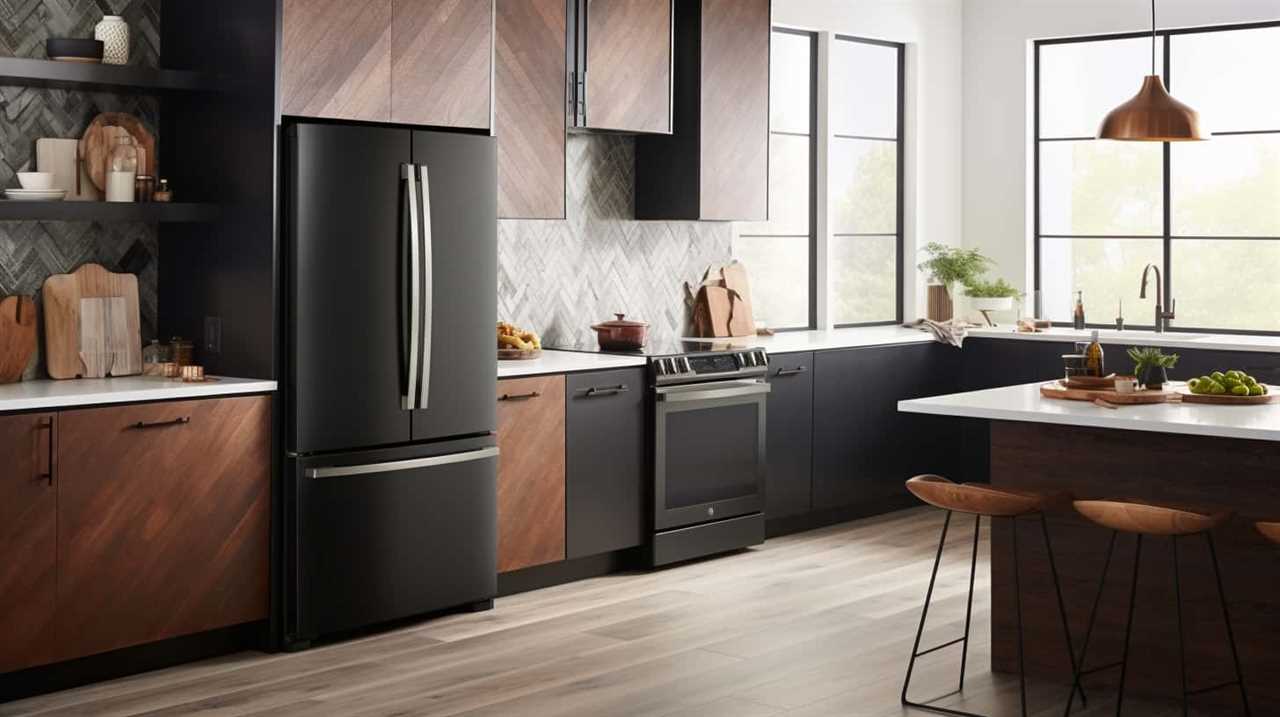
Can the Smart Coffee Maker Be Programmed to Brew Coffee at Specific Times?
Yes, programmable coffee makers can be a game-changer for every home chef. With the ability to schedule coffee brewing at specific times, you can wake up to the rich aroma of freshly brewed coffee, ready to kickstart your day.
Imagine the convenience of having your favorite cup of joe waiting for you when you stumble into the kitchen. It’s a small yet significant luxury that can make mornings more enjoyable and efficient.
Does the Smart Food Scale Provide Nutritional Information for the Ingredients Being Weighed?
Yes, the smart food scale does provide nutritional information for the ingredients being weighed. This feature is incredibly helpful for home chefs who want to track their calorie intake or ensure they’re following specific dietary requirements.
The scale connects to a smartphone app that displays the nutritional data in a clear and easy-to-read format. However, it’s worth noting that the accuracy of the nutritional information may vary depending on the database used by the app.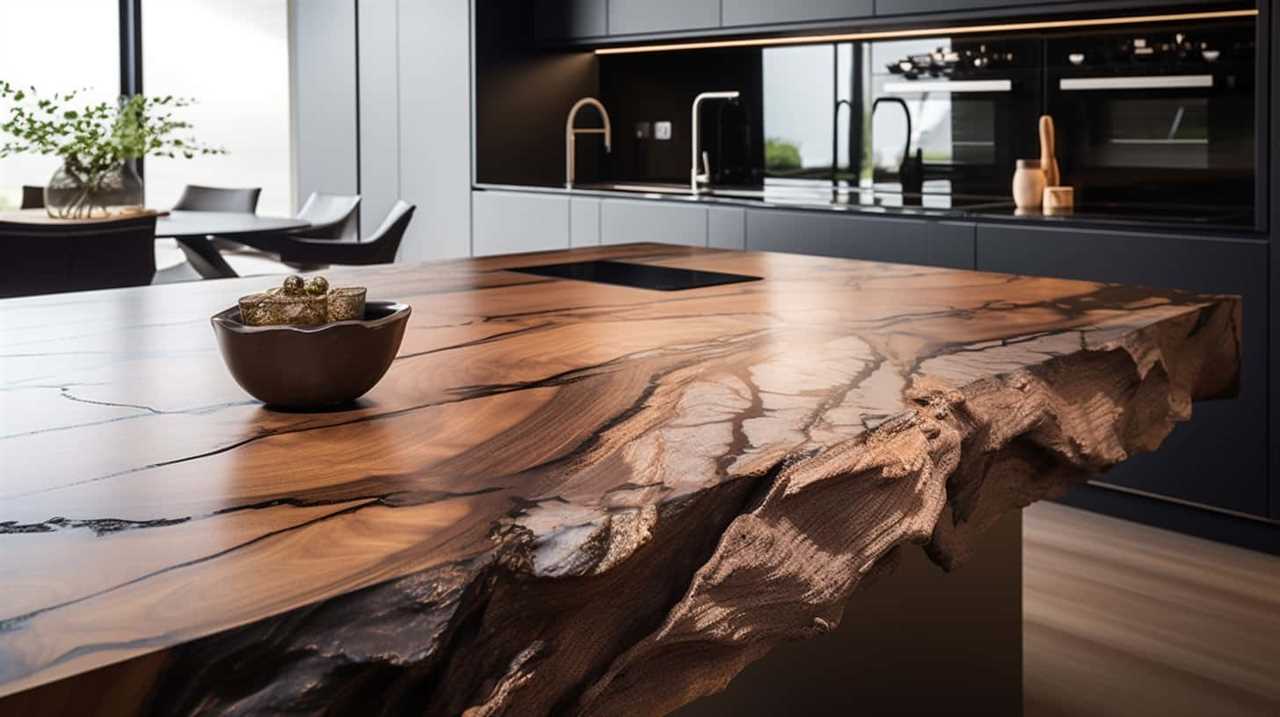
Can the Smart Pressure Cooker Be Used for Canning or Preserving Food?
Yes, the smart pressure cooker can be used for canning or preserving food.
It has a built-in canning function that ensures optimal pressure and temperature for safe preservation.
This feature allows us to can fruits, vegetables, and even meats with ease.
By using the smart pressure cooker for canning, we can extend the shelf life of our homegrown or homemade foods, preserving their freshness and flavor for longer periods.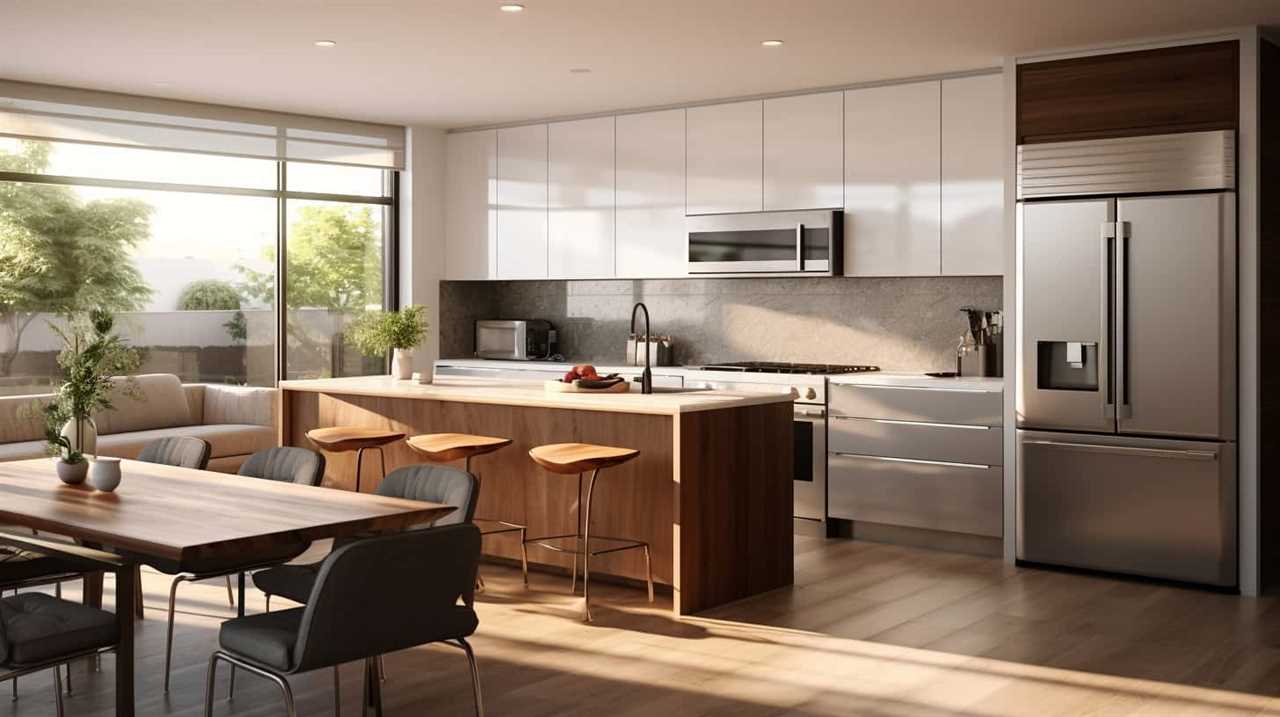
It’s a convenient and efficient way to stock up on homemade goodies.
What Makes These Kitchen Gadgets Essential for Home Chefs?
Every home chef knows the value of having the right tools in the kitchen. These smart kitchen gadgets for home chefs are essential for making cooking more efficient and enjoyable. From digital food scales to precision cookers, these gadgets help home cooks achieve professional results in their own kitchens.
Conclusion
In conclusion, these 10 smart kitchen gadgets are essential for every home chef.
With a smart refrigerator, voice-controlled oven, and Wi-Fi enabled coffee maker, cooking has never been easier.
The integration of recipe apps with a smart food scale and precision cooker ensures accurate and delicious results.
Additionally, programmable settings in the air fryer and blender, multiple cooking modes in the pressure cooker, and app-controlled features in the slow cooker take convenience to the next level.
Upgrade your kitchen with these smart devices and elevate your culinary experience.
- About the Author
- Latest Posts
Introducing Charles, the Editor in Chief at ByRetreat, whose passion for interior design and editorial excellence elevates every remote workspace to new heights. With his keen eye for detail, impeccable taste, and expertise in design, Charles brings a wealth of knowledge and creativity to the ByRetreat team.
As the Editor in Chief of a renowned lifestyle blog, Charles has honed his skills in curating captivating content and staying up-to-date with the latest trends in interior design. His deep understanding of aesthetics and the power of storytelling through design enables him to create remote workspaces that are not only visually stunning but also rich in personality and meaning.
Garage Door Opener
What Makes Torsion Bar Garage Door Openers Unique?
Heralded as the pinnacle of garage door opener technology, torsion bar systems offer unparalleled efficiency and innovation – discover what sets them apart.

When it comes to garage door openers, torsion bar systems shine like a smoothly running gear in a machine. Their intricate design and functionality provide insight into a realm of efficiency and creativity.
But what truly sets torsion bar garage door openers apart from the rest? Let's explore the mechanisms that make them a preferred choice for many homeowners and professionals alike.
Key Takeaways
- Space-saving design with wall-mounting and torsion bar operation
- Quieter and smoother operation with minimized vibrations
- Innovative torsion spring technology enhances efficiency and safety
- Enhanced durability and strength for reliable performance
Space-Saving Design and Mechanism
The space-saving design and mechanism of torsion bar garage door openers offer a practical solution for limited garage space. By being wall-mounted beside the door, these openers utilize a torsion bar for smooth and quiet operation, eliminating the need for overhead tracks. This setup not only saves valuable ceiling space but also contributes to a sleek and modern garage aesthetic.
The torsion bar, a key component of these openers, ensures a reliable and durable operation, making them suitable for both residential and commercial settings. The mechanism behind torsion bar openers allows for a quiet and efficient performance, providing users with a peaceful garage environment. The durability and reliability of these openers make them a popular choice for those seeking a long-lasting and low-maintenance solution for their garage door needs.
With their space-saving design and smooth operation, torsion bar garage door openers offer a liberating experience for users looking to optimize their garage space effectively.
Quieter and Smoother Operation

How do torsion bar garage door openers achieve a quieter and smoother operation compared to other types? Torsion bar openers excel in providing a superior user experience with their innovative design and functionality. Here are the key factors contributing to their quiet and smooth operation:
- Torsion Bar Design: The torsion bar system minimizes vibrations and noise, resulting in a quieter operation that enhances overall comfort.
- Even Weight Distribution: By distributing the weight of the door evenly, torsion bar openers ensure smooth and balanced movement without jerking or jolting.
- Durability and Long-Lasting Performance: These openers are built to last, offering reliable performance over an extended period while maintaining their efficiency.
- Minimized Friction: The torsion bar design reduces friction during operation, leading to a smoother movement that's both efficient and quiet.
Innovative Torsion Spring Technology
Pivoting from the discussion on quieter and smoother operation, torsion bar garage door openers incorporate innovative torsion spring technology to enhance efficiency and performance. Torsion springs are at the core of this technology, storing mechanical energy to aid in lifting and closing the garage door. This design not only ensures smoother operation but also makes the installation space efficient. Torsion bar openers stand out for their safety and reliability, attributes that are reinforced by the robust torsion spring system they utilize.
| Torsion Springs | Garage Door Installation | Safety and Reliability |
|---|---|---|
| Efficient operation | Space-saving | Enhanced safety |
| Mechanical energy | Compact design | Reliable performance |
| Long lifespan | Easy setup | Peace of mind |
| Durability |
With torsion spring technology, these door openers provide a balance of power and finesse, ensuring a secure and efficient garage door operation.
Enhanced Durability and Strength

Enhanced in durability and strength, torsion bar garage door openers outperform other types with their superior construction and longevity. Torsion bar systems are engineered to withstand heavy loads and frequent use, making them a reliable choice for long-term garage door operation.
Here are four key reasons why torsion bar garage door openers are renowned for their durability and strength:
- Robust Torsion Springs: Torsion bar openers utilize high-quality torsion springs that provide smoother door operation and increased strength compared to traditional extension springs.
- Longevity and Reliability: The torsion bar design enhances the overall lifespan of the garage door opener, ensuring it can endure years of continuous use without compromising performance.
- Reduced Wear and Tear: The unique construction of torsion bar systems minimizes wear on components, leading to decreased maintenance needs and prolonged durability.
- Handling Heavy Loads: Torsion bar openers are specifically built to handle heavy garage doors with ease, showcasing their strength and resilience in demanding operating conditions.
Customizable Options for Different Needs
With a focus on meeting diverse needs, torsion bar garage door openers offer a range of customizable options tailored to various garage door sizes and weights. When selecting a torsion bar opener, it's crucial to consider the specific requirements of your garage door to ensure optimal performance. The table below outlines some of the customizable options available for torsion bar garage door openers:
| Customizable Option | Description | Benefits |
|---|---|---|
| Torsion Spring Size | Different sizes available based on the weight and height of the garage door. | Ensures proper balance and operation. |
| Material Selection | Various materials like steel or aluminum can be chosen based on durability and budget considerations. | Offers flexibility and customization. |
| Tension Settings | Precise and adjustable tension settings allow for fine-tuning according to the door's requirements. | Enhances performance and reliability. |
Frequently Asked Questions
What Does Torsion Bar Do in Garage Door?
The torsion bar in a garage door system plays a critical role in balancing the door's operation. It connects to tension springs, ensuring smooth and controlled movement during opening and closing.
Which Is Better Torsion or Extension Springs?
Torsion springs are superior to extension springs due to their durability and longer lifespan. Positioned above the door, torsion springs operate by turning to open, making them space-efficient. They're safer and less prone to sudden snapping.
In contrast, extension springs are more susceptible to wear and tear, requiring more maintenance. For a reliable garage door system, we recommend torsion springs over extension springs.
What Are the Disadvantages of a Jackshaft Garage Door Opener?
Disadvantages of a jackshaft garage door opener include:
- Potential complexity in installation
- Requiring more clearance space
- Being pricier
- Limited availability compared to trolley openers
- Not universally suitable based on garage configurations
These factors can impact ease of use, cost, and compatibility. It's essential to consider these drawbacks before selecting a jackshaft opener for your garage.
What Are the Advantages of Screw Drive Garage Door Openers?
Screw drive garage door openers offer simplicity with fewer moving parts, utilizing a threaded steel rod for efficient door operation.
These durable openers require minimal maintenance, making them a preferred choice for heavy garage doors due to their smooth and quiet performance.
Cost-effective and reliable, screw drive openers are popular among homeowners for their effectiveness and longevity.
Conclusion
In conclusion, torsion bar garage door openers stand out in the realm of garage door technology due to their space-saving design, innovative torsion spring technology, and enhanced durability.
Like a well-oiled machine, these openers operate quietly and smoothly, providing a reliable and secure way to open and close your garage door.
With customizable options to suit different needs, torsion bar openers truly elevate the safety and efficiency of your garage door system.
- About the Author
- Latest Posts
Introducing Ron, the home decor aficionado at ByRetreat, whose passion for creating beautiful and inviting spaces is at the heart of his work. With his deep knowledge of home decor and his innate sense of style, Ron brings a wealth of expertise and a keen eye for detail to the ByRetreat team.
Ron’s love for home decor goes beyond aesthetics; he understands that our surroundings play a significant role in our overall well-being and productivity. With this in mind, Ron is dedicated to transforming remote workspaces into havens of comfort, functionality, and beauty.
-

 Vetted2 weeks ago
Vetted2 weeks ago15 Best Drip Irrigation Systems to Keep Your Garden Thriving
-

 Vetted1 day ago
Vetted1 day ago15 Best Foot Massagers for Neuropathy to Soothe Your Feet and Relieve Discomfort
-

 Vetted1 week ago
Vetted1 week ago15 Best Sports Laundry Detergents for Keeping Your Activewear Fresh and Clean
-

 Vetted1 week ago
Vetted1 week ago15 Best Tall Toilets for Seniors That Combine Comfort and Safety
-

 Vetted2 weeks ago
Vetted2 weeks ago15 Best Dish Scrubbers to Keep Your Kitchen Sparkling Clean
-

 Beginners Guides4 weeks ago
Beginners Guides4 weeks agoDesigning Your Retreat Center – Essential Tips
-
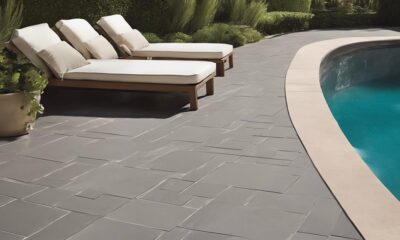
 Vetted4 weeks ago
Vetted4 weeks ago15 Best Tile Adhesives for Outdoor Use – Top Picks for Durable and Weather-Resistant Installations
-

 Beginners Guides4 weeks ago
Beginners Guides4 weeks agoAre Retreats Profitable





